#and more being like ''this is like my character its cool how our design sensibilities overlap''
Explore tagged Tumblr posts
Text
i dont want to get back on my soap box but you really dont need to be tagging other peoples OCs with your OC or fav charcter. Sometimes ill tag peoples OCs with my characters but i usually say "character adjacent" instead of implying that an oc is just a carbon copy of another thing
#i dont know if my tagging annoys people#for me its less like im claiming some other persons art in a way#and more being like ''this is like my character its cool how our design sensibilities overlap''
22 notes
·
View notes
Note
Hi there! As a pretty casual Avengers fan, I haven’t read too many runs that portray the relationship between Wanda and Vision. Why do fans like this ship? And why do some Wanda fans seem to dislike Vision? Are there any runs or comics that show the good or bad of this pairing?
Hello! I'm going to answer this question because I love these characters and I love to waffle about them, but also just going to remind people that I also have a personal account over at @brw where I talk more about stuff like this! This account is almost a portfolio of my graphic design, as well as an archive for comic art and editing resources and other graphic designers, with a few odd extra things I think are cool that I want on this blog. I try to refrain from posting too much commentary or the like here, just because I want to keep it very focused on my creations and the creations of other folks. With that out of the way, I'll dive into this!
Why do fans like this ship?
Well, I can only speak to my experience as a 616 ScarletVision fan, and from engaging with different fans through the years, but these are only my personal takes and some observations. Everyone you ask could give you a different answer, and none of them would be wrong.
For me, the personal pull is, first and foremost–I really like both of these characters. They both have a very distinctive design, they both have very strong core aesthetics, they both have dramatic, strong personalities and they both have a very distinguished speech pattern, so their relationship would always be interesting to me, because it combines so many different things that I love. Without being a fan of Vision and Wanda separately as characters, I wouldn't like this relationship as much as I do.
Anyway, beyond just generally liking their respective vibes, I've always appreciated just how dramatic and intense these two are. Vision and Wanda definitely feel like their respective first, proper adult relationship, at least in my opinion. This might be divisive, as Wanda and Warren Worthington III did date in First Class, but that relationship to me read more teenage and youthful, while Vision and Wanda are very much so swept in the emotional and physical intensity that they develop for each other very rapidly in their Avengers appearances together. That dramatic, strong personality they both possess makes their relationsip very dramatic and over the top, which I find a delight to read.

Giant Size Avengers #4 (1974)
Even when they get married, this drama doesn't really go away, and the bio of this blog comes from one of my favourite issues depicting these two and their dramatic sensibilities.

Marvel Super-Heroes V2 #10 (1992)
This panel brings us into our second reason, which is that there's something really interesting about the way these characters are both social outcasts for a variety of reasons; Wanda is Rromani, a mutant and a witch, and Vision is a synthezoid, completely non-human and unable to fit into human norms and customs. A big theme of these two and their relationship is having a similar lived experience because of the ways they are social outcasts, and of their love becoming stronger than the adversity that they face because of it.
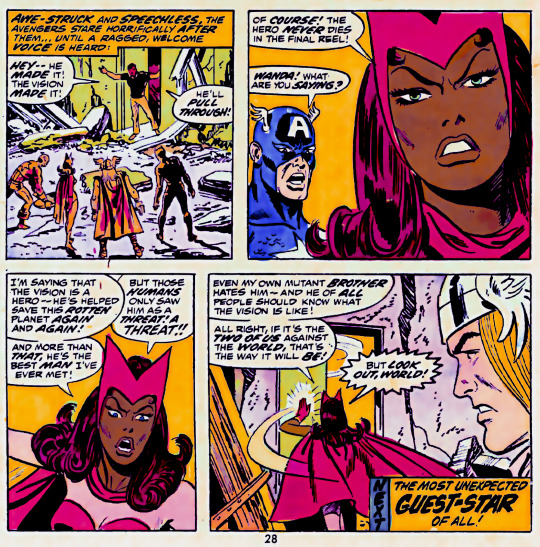
Avengers V1 #113 (1973)
To me, its a very engaging story, and it's well compounded by again, how dramatic and high-energy these two are, the ways they show and perform their love for one another. They're also often very bitter and angry at the world for the way it mistreats them, which is an interesting character trait for both of them as other characters (like Pietro) are often written as antagonists for those opinions. And this of course makes it more special when they are so tender and loving around each other, the ways they can find solace and peace in one another.
They also just generally brought out the best in one another during their marriage, in my opinion. Vision's stoic, dependable personality and their support for Wanda while she was exploring her magic with Agatha Harkness was incredibly important as she developed and grew from a mutant with magical themeing, to a powerful witch in her own right. It is Vision who taught Wanda the principal of "Order and Chaos belong together", which is a really important line of thought for her. And Vision of course becomes increasingly more in tune with their own emotions, more emotionally mature and more developed as a person as their relationship with Wanda develops. They go from a traumatised, bitter person angry at the world, with essentially no emotional regulation skills because they're like three days old, to being a loving, deeply compassionate and considerate spouse and parent, who has built their own family in spite of the isolation they grew up with.
There's probably other reasons I'm missing, but these are the big ones in my opinion, why I keep coming back to these two despite not being together for 30, 40 odd years.
Why do some Wanda fans not like Vision?
There are a few different reasons for these, so I'll do my best to be brief. Some reasons are more than valid and are worthy critiques and understandable reactions and feelings to have, and others, quite frankly, are complete horseshit made up by people who feel like their dislike of Lines On Paper has to be justified, or righteous, and can't allow it to just be. I'm focusing this list on specific reasons they dislike Vision, not people just preferring other relationships like WandaJericho or ScarletPhoenix or what have you.
Just not the type of character they like. Which is understandable. Not every character works for every person, and sometimes disliking a character isn't that deep! People are allowed to not like lines on a sheet of paper, after all.
Character and ship was ruined for them by the MCU, and MCU fans. Also understandable, although I wish that didn't mean that all the actually interesting parts of the 616 Vision/Wanda dynamic was ignored, but what can you do.
Has a difficult and varied history of being coded as a minority by various (very white, very American) writers during the 70s and early 80s, which have not aged well. A big inspiration for Vision was Spock from Star Trek, who is obviously a biracial character and faces a lot of discrimination for this, and this was part of the character makeup of Vision and it was often a source of allegory, as well as a source of drama in Wanda and Vision's relationship. Not an often well done aspect of their character, and not very tasteful. This writing turned off some people, which is understandable (although if you're asking me, which you are, it's not any more egregious than X-Men coding but that's neither here or there)
Vision's character development and prioritisation in the 70s came at the expense of Pietro. This one is true; Steve Englehart, for whatever reason, decided that as Vision and Wanda's relationship became more fully fledged and he was going to continue with Vision's minority coding, that Pietro was going to be an antagonistic and often allegorically racist person to give that dynamic more drama. This was fixed when Moondragon decided to lobotomise him because I guess actually writing character development was too much work, but it still means a solid chunk of Pietro's 70s appearance are marked by this. It's a shame, because I think there's a way to write this antagonism in a way that makes sense and is narratively fulfilling, but that's not the conversation at the moment. I do appreciate this as a reason of why some people have never quite worked with Vision (although given that this hasn't been true in the past 20, 30 odd years of publication history I find it strange as a reason to dislike modern Vision but I'm biased in this conversation)
Writers reduced Wanda to her relationship with Vision. This is, frankly, bullshit, and I really don't know where it came from. There's a slight argument for pre-Byrne Wanda and especially early 70s Wanda, but I can still name a few different issues during the period of their marriage where Wanda had her own adventure outside of Vision, and the thing is folks; Vision wasn't getting many solo appearances or stories during their marriage, either. Post Byrne, it really doesn't make sense. Wanda was reduced to her grief and her mental illness, yes, which were caused by the traumatic dissolution of her marriage to Vision, but that isn't the same as her being reduced to her marriage. Later on, what Wanda is reduced to is House of M and the Decimation; this has nothing to do with Vision. Sure, if you're reading Roy Thomas/Steve Englehart early 70s Avengers, maybe, but these are only two writers in a sea of people who have handled these characters, so this argument doesn't hold water for me.
Vision is abusive. Anyone who says this shouldn't be reading comics, they should be watching Blue's Clues. Vision can be mean, or blunt, or emotionally distant, or bitter–but that does not mean Vision is abusive, that means that comics exaggerate personality traits for the sake of drama. It's a soap opera! And to be honest, any argument you can apply to them can apply to virtually any comic relationship from the era. That's just the writing style, it doesn't mean that Vision is an abusive figure.
Vision made a robot version of Wanda, which was creepy and weird. True, but using a Tom King comic to talk about Vision is like using a Bendis comic to talk about Wanda. Neither of these writers had good intentions with these characters, or particularly cared about or respected them as characters and what they're meant to represent. Vision (2015) was a bad, deeply racist and xenophobic comic written by a CIA agent who admitted freely to torturing people as if it was a fun little tidbit. Unless you're using it to criticise Tom King's racism, I have zero interest in acknowledging this comic in the history of these two.
Vision's character comes at the expense of Jim Hammond and Simon Williams. I... don't see this one? Both the revelations that Vision had a relation to Jim and Simon came after their initial debut, and Vision is a distinct person and design from both these characters. Writers can use Jim and Simon whenever, and they often do. There is just that historical/familial connection, to try and build up connections in the Marvel Universe, but it isn't as if the character of Vision RUINED Jim and Simon, or whatever. In fact, Simon would have never been remembered and brought back from the dead to be honest without Vision keeping his character alive in the memory of people. The same is arguably true for Jim, who wasn't really used in post Timely marvel comics at all until the Vision connection was established. And if any character ruined Jim Hammond's prospects in comics, it would be Johnny Storm, the character who is considered the definitive Human Torch, not Vision, who only dedicated comic fans probably know of the Jim Hammond connection.
Vision cheated on Wanda with Mantis. A) no they didn't, B) Steve Engelhart just has a weird cheating thing, so I really don't consider this a big deal. Don't believe me? In the Fantastic Four: Big Town series he did, there's a moment where it is heavily implied that Hank Pym and Charles Xavier are having some kind of affair to contrast with the affair Janet and Tony Stark are having. It's just a quirk of his. Also, you can't blame Englehart for making everyone fall in love with Mantis, that's his girl.
Vision has no emotions and can't emotionally fulfil or love Wanda. Anyone who says this has probably not passed basic English class, because my G-d, how do you miss the point of a character that badly. Avengers #57 didn't die for this.
And finally, I think a lot of people only care about Wanda in relation to the Magetfam dynamic and aren't particularly interested in her realtionships on the Avengers at all, despite the fact that that is who she is far more than being an X-Man. They don't really like that she's on the "cop team", so any relation to it is dismissed or ignored in favour of her having more relationships with mutant characters. Every time Vision appears in a Wanda comic, despite the fact that they are the parent of her children, someone she spent years of her life with, her first proper love and someone she wanted to spend the rest of her life with, it has to be "forced", regardless of how ridiculous an idea that is. It's dumb, and stupid, and I don't think these people really care about Wanda as a character, but that's probably just me being a nasty little hater.
Runs and comics I recommend for this couple
Good or bad can be subjective; I've seen people read completely differently into a scene I thought was sweet, or creepy, or whatever, so I'll just send a list of what I consider good issues to get a handle on these two. Bolded are important, italics are just bonus issues that might be of interest.
Avengers V1 #91–#93
Avengers V1 #96
Avengers V1 #113
I (heart) Marvel AI <- AU issue, but cute
The Celestial Madonna arc (#124, #125, #129–#135, Giant Size Avengers #2–#4)
Avengers V1 #147
Marvel Team-Up V1 #41–#42
Marvel Fanfare #14
Marvel Fanfare #58 (Their house here is burned down in Avengers V1 #252)
Marvel Super-Heroes V2 #10
Vision and the Scarlet Witch V1 & V2, V2 also crosses over with West Coast Avengers V2 for the first 4 or so issues.
West Coast Avengers V2 #34–#36
What If? V1 #20, #38
West Coast Avengers V2 #42–#46 is the Vision Quest arc, and is the dissolution of their marriage.
Hope this helps, anon!
34 notes
·
View notes
Note
Yeah those are really interesting questions that I've thought about as well. I agree about not having the cultural dress be closed off, but no matter who wears it I want people to know where it came from. I cringe when I see clothes and jewelry advertised as "boho g*psy" lol.
As for different groups within Greece Im not exaxtly sure, I dont think it should be closed off either but to still respect the origins of each piece. Idk cause like my grandparents are each from differnt regions and like how far back do you go? And Im not too worried about losing regional character as our current modern clothes are way more of a threat to that. Either way people generally arnt wearing the traditional stuff for normal wear so maybe this is the least of the concerns.
Another thing I have thought about is how much should you alter the clothes to suit modern styles? Like is it disrespectful to shorten the skirts? Honestly I dont think so.
Well for one there are greek designers making clothes inspired off trad stuff but I personally think they tend lean too much into the modern side for my liking, but they will often have short skirts.
Another reason why I dont think its a problem to alter traditional clothing is that I think if we want to continue our culture and for it to grow and evolve we need to be okay with adding our own tastes and sensibilities thats not a bad thing and I think it shows a love of the culture rather than a disrespect.
I think though where there is specific traditions about the meaning of peices like the talismans you mentioned then it should be respected and followed.
There is a movement in china where young people are wearing traditional hanfu in the streets. There is a girl on instagram named mochihanfu who blends traditional and modern for normal wear. And i find it so inspiring and cool.
Maybe I am in the minority of being interested in wearing traditional stuff in normal wear because I like alternative fashion so I am used to standing out. But one things I've learned from this is that so many people WOULD wear more different kinds of things if they werent so afriad to not conform.
Queen what do you know about traditional style jewelry? I might go "fuck it" one of these days and start wearing it if I can find similar or affordable ones
Hii! I have only one post (just search the word "jewelry" and "traditional jewelry" on my blog) but my idea is that you can go to the folk museum of your area, or google about it and find articles that detail their appearance and use.
I am also trying to find similar and affordable ones, as well as buy from some who still make them. But people with this skill are rare to find and also share the sentiment that trad jewelry is for specific contexts like exhibitions and tradition-history themed events. I understand them, because you can't just shove traditional clothing into modernity, buuuut... why shouldn't we engage with the clothing and jewelry our people were making and proudly wearing for centuries?
As our society currently is I find it impossible to wear trad looking jewelry outside without looking out of place or like a poser. So I think we should start conversations so both sides can understand one another and so we understand where the line of respect is for our own stuff.
17 notes
·
View notes
Text

Please continue making old shooters easier ⊟
I’ve been, um, recently writing regularly regarding remakes of rare shooting games, and they all have had something to offer. Cotton Reboot offered modern style and sensibility to a classic game (along with a port of the classic itself), Zombie Nation offered, at the most basic level, the first wide availability of a very weird and notable game.
Ratalaika’s port of the Mega Drive game Gleylancer exemplifies my favorite aspect of these rereleases: I can cheese the heck out of it.
1992 JC would have dug Gleylancer, but I didn’t have the bucks back then to import a Mega Drive game from the Chips & Bits catalog. Basically, it’s a side-scrolling shooter with “option” style ships that fly around with you, like Gradius. Except you can pick up powerups to change the options’ weapons in seven different ways, like 5-way or Laser.
More importantly, you can choose how the options behave. A setting available at the start of the game allows you to choose whether they shoot behind you, in front of you, whether they circle you, etc. In itself, this is a very cool customization, but the modern port totally one-ups it by letting you aim the options’ shots yourself with the right analog stick, effectively making a twin-stick shooter out of it.
I’m sure this wrecks the initial balance of the game, by making it much, much easier to aim a barrage of multiple guns at enemies, but… good. 1992 JC would only have enjoyed a game like this for a rental period, having barely cleared the first stage. Here in the beautiful perfect future (let’s pretend for a minute) I can hold my own against a game designed to punish me. And what was originally a very well-designed feature for its time is now even better. I’m sure if controllers had dual analog back then, Gleylancer would have supported it.
Furthermore, like many retro ports, I have immediate access to a rewind button. If I wanted to, I could ignore that button and enjoy the difficulty of the game as designed. But I don’t want to. I want to cheese my way through the game, no matter what it says about my character. I find it tremendously satisfying to be able to get through a game I never would have had a chance to finish.
And these features aren’t just for people like me who are just regular bad at action games. Features like rewind and save states offer crucial accessibility to more people who might never have been able to enjoy a game like this before. And all the accessibility and difficulty modifications are totally optional, and can be ignored at will by people who don’t need or want them.
Next week, Ratalaika will publish a port of Gynoug, originally released here as Wings of Wor, and I look forward to being able to play it for more than 15 agonizing minutes at a time!
youtube
JOIN CLUB TINY AND OUR DISCORD Support Tiny Cartridge!
54 notes
·
View notes
Text
Every Marvel Cinematic Universe TV series to date has had its own distinct look and feel, from the sitcom-derived pastiche episodes of WandaVision all the way back to the grim-and-gritty, dimly lit street narratives of Jessica Jones and Daredevil. Marvel’s Loki has been one of the MCU’s more distinctive-looking series, though, from the dimly lit, industrial-brown corridors of Time Variance Authority HQ to the vivid neon city of Sharoo on the doomed moon Lamentis-1.
Series director Kate Herron confirms that some of these designs were directly inspired by classic science fiction, while others were more personal experimentation. We sat down with Loki’s cinematographer, Autumn Durald Arkapaw, to break down what went into designing some of the most striking and memorable sequences from the series’ first three episodes.
This interview has been edited for concision and clarity.
EPISODE 1: TIME THEATER INTERROGATIONS

Autumn Durald Arkapaw: Kate [Herron]’s sensibilities led me to get the job in the first place. We shared those sensibilities, around noir films and more moody thrillers, so we were already on the same page as far as lighting and tone. So when it came to the Time Theater, Kasra [Farahani], the production designer, did a fantastic job of creating a space that had a lot of opportunity to feel textural and moody, and create symmetry. I’m big on symmetry. I like to frame center-punched, keeping in mind the architecture of the room, and framing for the architecture and the people at the same time. Stanley Kubrick does that very well. A Clockwork Orange obviously came up in our discussions. Some of our main references were David Fincher’s Zodiac and Terry Gilliam’s Brazil, and the original Blade Runner, in terms of creating spaces that feel strong and weighted, with the people in them placed in a way where the conversation feels very heavy, so you’re paying a lot of attention to the lines, and where your eyes are drawn.
We did some lighting changes above, in the Brutalist ceiling. The lights move, so when we’re cutting back and forth, you see the lights change on the actors. We’re trying to time those movements to the dialogue. The editing was fantastic with that scene. We shot a good amount of coverage, and [series stars Tom Hiddleston as Loki and Owen Wilson as Mobius] play in that space a lot. So we’re trying to always keep it interesting, every time they go back there, changing up the lighting and the projections. That’s probably one of my favorite spaces in the show.
And then the acting, obviously — they’re riffing off each other, and you’re in the room with them and feeling the energy. It was very exciting. That scene was up front in our schedule, so Owen and Tom were getting to know each other in general. We got to watch that happen before our eyes, and it was very comical.
One of the most noticable things about that space is the harsh, rectangular overhead spotlights — Tom Hiddleston starts his interrogation under a spotlight, and when he gets angry, he moves himself back under it. How did you discuss that kind of blocking and framing?
The thing with Tom is, he’s a genius. He’s just a fantastic actor, The amount of things I could say about how amazing he is on set, and character-wise, the list goes on and on. You can introduce marks and let actors know where you’d like them to be for a shot, but that doesn’t necessarily mean that’s where they’ll go. Some actors like to be more freeform. But with Tom, I wouldn’t have to say “Stand under that light.” He just knows, and he’ll play off that because of the space. He walks in, sees how it’s lit, knows our agenda, and uses that in the character.
So there were certain moments where he asked, “Is this what you’re thinking?” or we would have a discussion. But mostly, he uses the environment around him to tell the story as well, and he took in that lighting as part of the character. Actors know how they look in certain types of light. He’s very good at that. So he played with that in that space, for sure.
When we pull back and take in the whole room, the lighting feels punitive — the striped shadows are noir-movie standards, like light coming through blinds, but they also feel like prison bars. Is that something you discussed?
We never talked about prison bars, but in designing that space, Kasra was thinking about what that space was — being arrested, and being judged. It’s a claustrophobic space. Loki is slightly free to communicate and move around, but the walls and ceiling are concrete, there’s this fake light coming in, because obviously, in the TVA, there’s no day or night. You can see the light moving above, but there’s no sun there. It’s just moving at certain moments.
I had an idea, after seeing the latest Blade Runner, where Roger Deakins moves the lights around: Why don’t we have the lights move? It’s not easy to have big tungsten light sources above a ceiling set move like that, because it takes heavy motors. But my gaffer and key grip are amazing, and they figured out a way we could move the lights without causing shadows between each of the sections of lighting. It looks all like it’s moving at the same time. That took a lot of thought, getting those lights to move, and not just creating shafts of light that fade in and out. I think it helped a lot, because it’s very subtle. You’re only going to see it as they’re sitting. You’ll see sometimes the light moves from Owen’s shoulders into his eyes at the right moment, when you get lucky in the edit, and catch it at the right moment. It was great to have the resources to actually do stuff like that.
EPISODE 2: THE ROXXCART VARIANT PURSUIT
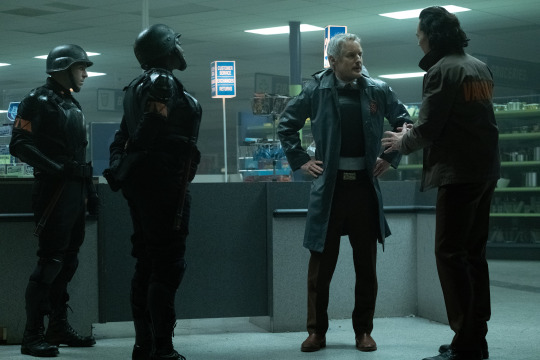
I’m a fan of green. If we’re designing a clinical environment, or a shopping mall, and we’ve got overhead fluorescents, I like to use cool white fluorescents that have kind of a green kick. I’m a big David Fincher fan, and there’s an undertone of green in his setups that I appreciate. So Roxxcart is a bigger shop that is now closed down, and Kasra outfitted it like a big-box Costco-type place? That wasn’t a full set — we went to this big warehouse, and he made it feel like that kind of store.
Above the space where we shot in, there were a bunch of fixtures. We completely removed those and put in our own tubes. They were RGB, and we could fade them and turn them off and on to our liking, flicker them, make them red when we wanted. When they’re cool white, I appreciate that green kick. I did a lookup-table color correction as well, to give it that tone. It’s meant to be clinical, but make you feel like you don’t know what’s at every turn. And we’re keeping lights on or off depending on which way we’re looking. Kate was a big fan of that space being very dark, with pockets of light. Our antagonist is supposed to come out of the darkness as people change identities.
We’re also trying to make that space look bigger than it actually was. We’re creating depth with light. That was a bitch to shoot — we had so much rigging. My team was amazing. If you go into a space like that, a Target or something, you’d think “The lighting here is not that big of a deal. It’s just overheads.” But being able to control all those overheads and make them different colors and flicker them takes a lot of rigging, with a dimmer board and the programming. In the editing afterward, it really does feel like a space that’s a lot bigger than it actually was. The red sequence is one of my favorites, for sure.
The camera is below waist level a lot in that sequence. What are you communicating there?
I always like to shoot low! It’s just how I see things. Some of my favorite films are detective thrillers from the past, Zodiac being one of those. I’ve always just loved shooting below the eyeline. Obviously there are moments in features I’ve shot where I want to be higher, because it’s more emotional or romantic or something. But in this kind of story, where you have these amazing spaces, and you have multiple characters you’re trying to frame, all facing off and being strong, I’m just a bigger fan of seeing a ceiling than a floor. It’s an appreciation I have, as far as it feeling more mysterious. When a character is looking more mysterious, and you’re not trusting them, you’re trying to figure them out, I love that kind of framing. It’s amazing.
EPISODE 3: FIGHTING TO REACH THE LAMENTIS-1 ARK
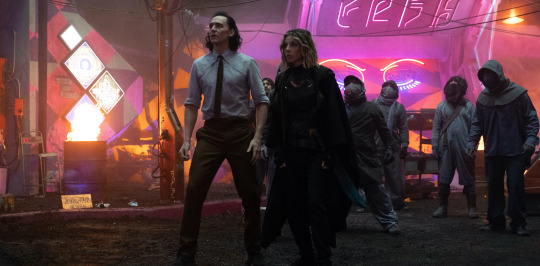
That sequence has a great backstory. I did a lot of prep with Kate. We started prep in Los Angeles before we ended up in Atlanta. We knew that sequence was coming up. but in the script, it just says “Okay, so they end up at Sharoo, and then go on.” The description of that sequence went through an evolution, with the filmmakers discussing things, building the set, and collaborating, so early on, we spitballed about what we thought that could be. Having the support of Marvel and being able to build, and being able to do great stunts, we went bigger.
With the sequence as it evolved, Children of Men was a big reference for us. Kate was really interested in that feeling. She wanted to be with the characters the whole way. We tried to figure out, should the camera be handheld? Should it be Steadicam? We ended up with Steadicam. We looked at some previous oners, because we wanted this sequence to feel like a oner to the audience. Obviously, there are cuts in there, but we seamed certain shots together so the audience wouldn’t feel as though we cut. The intention was to feel like you’re on the run with Loki and Sylvie, racing to the ark, building up tension. You’re there with them as they’re fighting.
My husband’s a DP, and he shot True Detective season 1. That oner in True Detective was something we looked at as well, because it’s just one of those great oners that feels real and has those kinds of textural elements. We did pre-viz, we did rehearsals in the space, prior to shooting there. We went there a couple times and did camera rehearsals. We had an amazing Steadicam operator who I’ve worked with on my last four projects and features. He’s very in tune with my eye, and he’s great with those kind of moves. Kasra understood that we needed certain paths to go down, to help us get from point A to point B, so it feels like a run, it doesn’t feel like people keep entering the same space. Obviously, it’s hard to build really big sets where you can go very far. So he did a great job of knowing what we needed, and then adding stunts, and figuring out how we could feel like we were turning corners whenever we’re moving into different spaces.
How big was the physical space? How much of what we’re seeing there is digital?
Shiroo was very different from Roxxcart. At Roxxcart, we had blue at the end of the aisles, so they look like they’re going on a lot longer than they are. But we traveled to that space. It wasn’t built. Shiroo was built on a backlot. That was a set we had full control over, to build to our liking. Above a certain point, as you’re looking up at the buildings, that’s VFX. But we built the actual buildings up to a certain height, and then beyond that is a digital extension. As far as the depth as well, beyond a certain part of the street, it’s a digital extension. Obviously, the ark is an extension, and we’re using the explosions as cues to do a lot of lighting cues. But it was a very big set, a gorgeous set. It has a lot of texture.
Kasra had the idea of painting a lot of the set in black-light paint, which I’d never seen before, and putting black lights everywhere. Also, we had a bunch of units on top that lit the set for the moon color and those sources, and we had VFX helping us stitch it all together. We had to shoot the sequences and look at the overlays on set to make sure we were creating matchups that would work in the final edit.
For me, that’s a very successful collaboration of in-camera elements — that whole set was real — and having explosions on set along with lighting cues, and then the effects to seam it together and do the extension above and the depth. So everyone really had to play like a good chunk of that. But they’d be effects overall, I think taking what we shot and making it feel like something that big, you know, the buildings are falling. Obviously, we didn’t drop buildings on people. There’s some foam stuff. That was really fun. We shot all that stuff at night.
The camera work in that sequence is some of the most dynamic movement in the series. What was the most difficult part about coordinating that sequence for you?
Rehashing it now, it was the prep. When we were actually there in the space with Tom and Sylvie, running through all of this stuff, it really made sense by that time. We’d been pre-vizing it and reworking it and massaging it for so long that ultimately, once we got on the set and had to follow them with the camera, and the energy was going, and we had the extras there, it all fell together. I think one day, we even wrapped a little early, because we’d just nailed it. When you’re prepping those types of shots, in your mind, you’re always like, “This is gonna be hard, it’s going to be difficult to seam these together, I like perfect headroom.” And you also want it to feel real, and people have to jump and fly and tumble into the frame. But on the day, our execution ended up being pretty good. So that was the most surprising thing to me, because it was kind of a pain in the ass prepping, because there are so many elements. And we’re doing six episodes, so we’re always working, trying to chase the next prep. But it really fell into place nicely.
62 notes
·
View notes
Photo



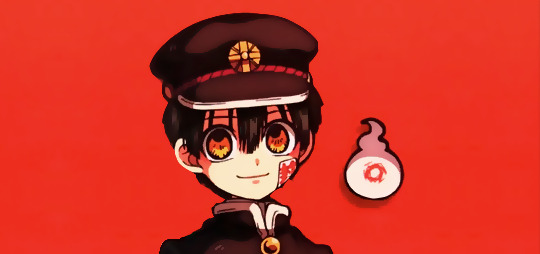

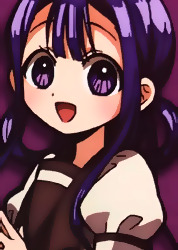
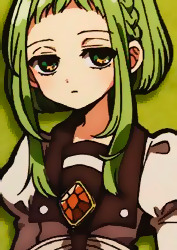
“Hanako-san, Hanako-san, are you there?”
Happy anime release date! (staff and cast comments translated under the cut)
Author, AidaIro
“Hanako-kun” continues its serialization while borrowing the strength of several people, but this time, we received the terribly fortunate help of even more people and a TV animation was green-lit! It was blessed with extremely brilliant, passionate and best-ever staff members, so I have the happy presentiment that it will turn out as a fun anime! AidaIro and Mokke are ready to cheer for and watch it at full power, so please, let’s all enjoy the Hanako-kun anime together!
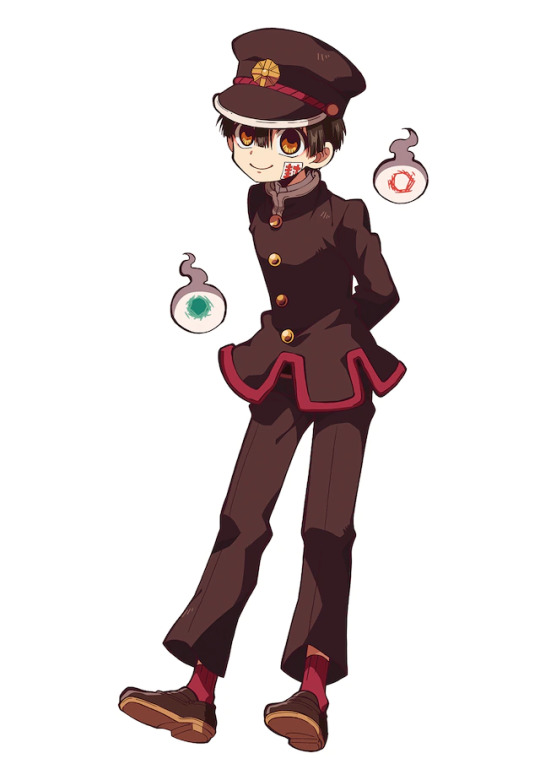
Voice of Hanako-kun, Ogata Megumi-san
I was extremely happy! After I received the offer, I became obsessed with the charm of the original work the very instant I read it. It was almost as if I had swallowed those mermaid sca… oops, please see the actual story for the rest (laughs).
This is a series where “School Mysteries” – which shine within the heart of anyone at least once, regardless of what generation they belong to – are portrayed endearingly, sensibly and captivatingly. I will do my best so that I can sharply raise my synchronization ratio with Hanako-kun, who is a big sadist that has nothing but cuteness to him and is also a little perverted despite being floaty and soft.
Together with these creators and staff team that I trust, stellar young members and skilled fellow veteran voice actors, I shall take you all into a tremendously exciting and thrilling whimsical world. Please have expectations for it.

Voice of Yashiro Nene, Kitou Akari-san
I am the one voicing Yashiro Nene, Kitou Akari!
I purchased and read the first volume of the original work “Jibaku Shounen Hanako-kun” during the time when the paperback was released. I would never have imagined that I would be selected to do Nene’s voice! When I passed the audition, along with happiness, I also had a surprise, like, “I was selected to voice this adorable Nene-chan…!?”, but as a fan of the original work, I think it would be great if I manage to finely express the image I have of Nene and that wonderful worldview to my utmost! I will also do my best with all my effort so that both the fans of the original work and the people who will be seeing it for the first time through the anime may enjoy it!
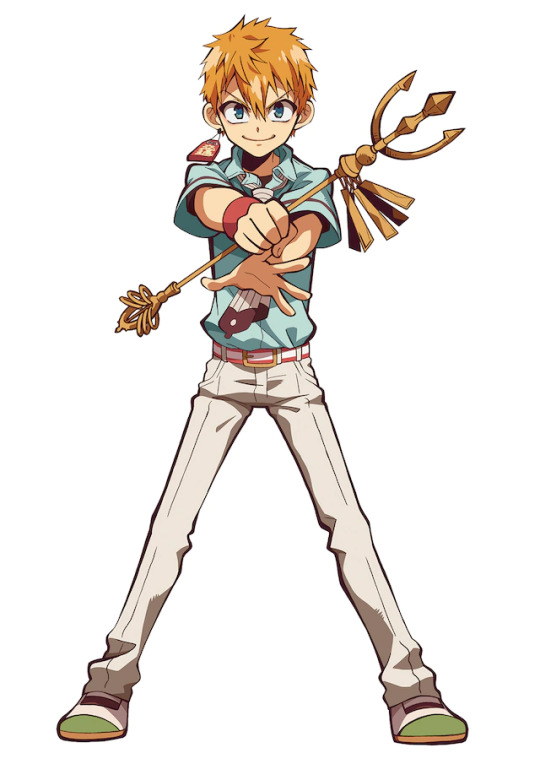
Voice of Minamoto Kou, Chiba Shouya-san
I read the original work during the audition, and amongst the fun touches that had many parts to laugh about, the sensitiveness and empathy towards emotions that make your breath halt pile up, so I was very drawn-in. I was extremely happy to actually have been put in charge of voicing Kou. I feel a charisma from his straight-forwardness and kindness. Amidst his middle-scholar-like liveliness, there are youthful activities, filled with sagacity. As a guy, I think it is really cool how he can make you feel that there is a possibility of growth for him even when he is confrontating something. I am performing to the best of my abilities so that I can express his goodness. I am also exceptionally looking forward to seeing Kou and the others moving around energetically. May the anime “Jibaku Shounen Hanako-kun” reach many people. We will be in your care!
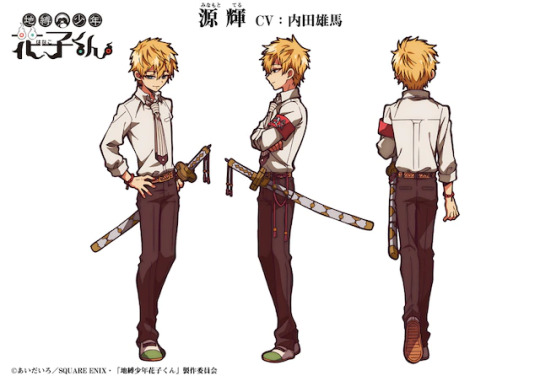
Voice of Minamoto Teru, Uchida Yuuma-san
I am the one playing Minamoto Teru, Uchida Yuuma!
I read “Jibaku Shounen Hanako-kun” for the first time during the audition, and I was able to keep reading without getting scared thanks to the eerie existence of so-called apparitions being drawn with a sensible touch and pop colors. The story also has a comedic tempo, so I am looking forward to the dialogues!
The one I voice, Teru, is Kou’s older brother. He is normally gentle and cool with anybody, and is also the object of Kou’s much esteemed admiration. I hope to enact this reliable Onii-san successfully. Please do enjoy the suspicious and adorable animation of “Jibaku Shounen Hanako-kun”.

Voice of Akane Aoi, Satou Minako-san
I was the one chosen to play Akane Aoi-chan, Satou Minako!
When I was first told that I had been approved as Akane Aoi-chan, I could not believe it at all and my head went blank. I want to love Aoi-chan, who is the number one popular girl in school and adorable no matter from what angle you look at her, enough not to lose to Akane-kun, and keep voicing her!
This is my first time performing in an anime, so I am filled with anxiety and nervousness, but I go for the challenge during the recording every day while being helped out by the kindhearted cast members and the people from the production.
Hanako-kun is the best series, as it overflows with love, is warm and interesting, and makes your heart throb! I will put my soul into it to my utmost and do my best in order to develop together with Aoi-chan!
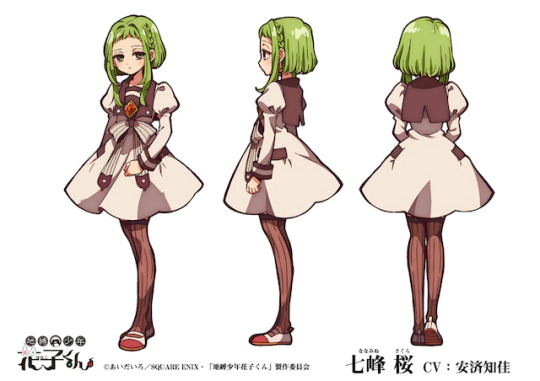
Voice of Nanamine Sakura, Anzai Chika-san
I will be the one playing Nanamine Sakura. This is Anzai Chika.
I believe people have interest in the Seven School Mysteries once in childhood. When I read the original work, I remembered for the first in a long time that feeling from childhood, where I had suspicions about your daily life and my heart raced at thinking about hypotheses regarding apparitions.
This is also a kind of romance…!
While drawn with comical cuteness, it sometimes makes your backbone freeze and sometimes suffocates your chest with feelings… This world-building and story soon stole my heart. While looking forward to watching it as a spectator, I am happy to engage in it as Sakura.
Sakura is still an individual with many mysteries surrounding her in the original work, but I will do my best to be one of the people who will invite everyone into this story and make you all its captives.
Please support the anime along with the original work!
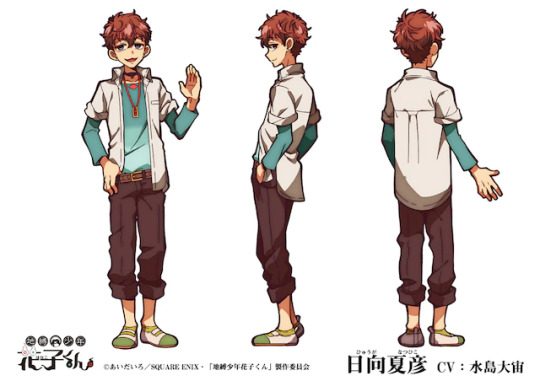
Voice of Hyuuga Natsuhiko, Mizushima Takahiro-san
This time, I will be playing the role of Hyuga Natsuhiko!
If anyone ever made a “Mizushima’s tendency and countermeasures” quiz, and if it had the question “What role does Mizushima play amongst the ‘Hanako-kun’ characters?”, he is the kind of character that makes you firmly hooked on him in a natural way, enough that you would be able to answer “Natsuhiko” without missing a beat! Therefore, I want to perform him enjoyably, anyhow!
Director, Andou Masaomi
I enjoy scary stories and adore school ghost stories, but I like bizarre yet delightful mysteries even more. No, I like Mokke. I also adore Hanako-kun, who lives in the girls’ toilet despite being a boy, the cute Nene-chan, who has fatty ankles, that guy who has super lame communication bias, and everyone else. And also Mokke.
We will soon be able to meet them, who are amusing yet somewhat miserable, in the world of animation as well. It is currently in the process of production! Mokke, that is!
Look forward to this heartfelt toilet horror comedy! Please! Mokke!
Series composer and scriptwriter, Nakanishi Yasuhiro
As someone who sensed the so-called Seven School Mysteries as something romantic during grade school, Hanako-kun felt like a nostalgic yet new existence to me. Sadly, there was no such thing as coming across school mysteries back then, so I am happy to have now met the Seven Mysteries of Kamome Academy in this fashion. I am enthusiastic about conveying them to the fans of the original work, in which Aida Iro-sensei draws obscure yet lovable mysteries, and to the people who will come in contact with the series from now on.
Character designer, Itou Mayuka
Jibaku Shounen Hanako-kun, congratulations on the TV animation being green-lit! I am the one in charge of the character design; my name is Itou. I am working on the production while wondering everyday… about how we can draw out the unique worldview, wonderful color usage, the cuteness and coolness of the characters that start out from Hanako-kun and Nene-chan, amongst other things, to their maximum. I will be drawing with all my might in order to please the fans of the original work, so please wait while looking forward to the airing date!
Animation producer, Higa Yuuji
When I first read “Jibaku Shounen Hanako-kun”, since my staple foods are traditional Japanese style, youkai, mysteries and ghosts, an image of Hanako-kun and the others talking and moving immediately played out inside my head. “This is great!! We should totally make it into an anime through Lerche,” I thought, and soon suggested to Square Enix that I wanted to make it into animation. Several comrades gathered up thanks to the power of the original work as well, and we made it to this point soundly. We fellow staff members are doing our best so that the images I pictured may be conveyed to everyone, so please cheer for us.
ANCHOR (from ZiNG)
I managed to make a cool ZiNG-like composition by borrowing the strength of lots of people, such as my great senpais, Ooishi-san and Ikuta-san, and everyone from ZOC. It goes without saying for the singing voice and the performance, but I would be happiest if I get to support the series as a fan with this song, of which the lyrics I put all the love I have for “Jibaku Shounen Hanako-kun” into.
Ikuta Youji (from PENGUIN RESEARCH)
I am always singing either in a band or as a voice actor, so it was my first stump singing with someone as a vocalist. And the other person was Ooishi-san, who I look up to, no less! I would be happy if the coolness of the OP hits home, of course, but also if the joy of making a composition together with everyone could be conveyed too.
Ooishi Masayoshi (from PENGUIN RESEARCH)
This time, I am doing a duet with Ikuta-kun and a chorus with ZOC was also added, and for me, there were many first-time challenges such as rap parts and singing with several people, so it was a very exciting recording. I hope everyone can listen to it with a fresh sense of taste!
#jibaku shounen hanako kun#jshk#tbhk#toilet bound hanako kun#hanako kun#hanako#yugi amane#yashiro nene#minamoto kou#minamoto teru#akane aoi#nanamine sakura#hyuuga natsuhiko#anime#shounen#color#cast comments#my translations#aidairo
693 notes
·
View notes
Note
So I'm curious what are some character designs you love? Not from RWBY, but just i general. I'm the same anon who got you to check out Berserk and I'd say essentially all of the designs are done damn well. Fit the character. Changes that makes sense for growth. Also make sense given the setting. Even women in armor that doesn't have those massive boob plates. Good designs impact so much subconsciously to have much we enjoy other aspects of a story.
Congratulations! You’ve unlocked my never-ending need to praise Yu Yu Hakusho! :D
This long, picture-laden post needs two disclaimers going forward:
I’m not an artist. In the sense that I’m not a visual artist who knows anything about what makes character design good from a technical/community approved standpoint. This is purely based on my own, personal reaction to a beloved series.
Connected to that, I’m going into this under the assumption that people might really disagree with me (?). Based on the cartoons and anime that I see praised for character design, I don’t think YYH fits whatever list more knowledgeable viewers are pulling from. But I’m gonna lay out my thinking anyway!
Major spoilers for Yu Yu Hakusho below.
Alright let’s do this.

First off, when people start talking character design they often reference how cool a character is. Which makes sense. You want a character to be visually engaging and distinct. Something that makes you go “Wow!” whenever you look at them. However, one of the things I love about the YYH cast is how normal they are. Because they’re supposed to be normal. The trope of the main character having a crazy hair color has become so prominent that we’ve got memes about it now and that works for a lot of stories. You know who is important because, despite the assumption that they’re average people not dying their hair, they stick out like a sore thumb among the rest of the cast.
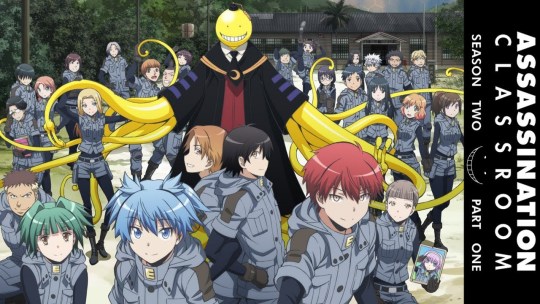
However, normalcy is a really important part of YYH. The entire point at the start is that Yusuke is not special. He’s not unique. He’s a delinquent kid who most assume isn’t going anywhere in life. When he dies this doesn’t unlock some Super Special Backstory - you were innately amazing all along! - he just gets caught up in the plot because of a paperwork issue. The afterlife doesn’t know what to do with an asshole kid who unexpectedly saved another kid’s life so they just kind of... shuffle him around until he’s given another chance to live. Then he gets to pay back that second chance by becoming a Spirit Detective. Yeah, Yusuke is talented when it comes to fighting and spirit energy, but at the start that’s rarely emphasized outside of “He’s the best street fighter among no-name street fighters so really, it’s not impressive once you take Yusuke out of his tiny world of school parking lots and the occasional alleyway.” The takeaway is that he’s a dime-a-dozen troubled teen who got involved in the spirit world due to an impulsive act and a bunch of bureaucracy. Indeed, it’s a HUGE moment of emotional growth for Yusuke to realize that people do love him despite his supposedly average, unremarkable, and otherwise negative personality. His normal-ness - and others’ expectation that he could someday make himself great if he learns to work at it - is crucial to where Yusuke starts out. Making him visually distinct in terms of Anime Protagonist Looks would undermine a lot of that. This isn’t supposed to be a Super Special Kid Destined For Greatness. He’s just... a kid. A normal kid. A kid who has to work and learn and grow if he wants to make something of himself. So he gets black hair, brown yes, and a green school uniform. He’s pretty damn average looking.
Same with Kuwabara. Same with Keiko. Same with Atsuko. They’re just normal people going about their lives and I always appreciated that they looked the part. You can still easily tell them apart thanks to different hair colors, texture, jaw lines, and outfits, but none of them seem out of place in the average world they start out in. Which, as said, is crucial to a lot of YYH’s themes. The ones who look more visually distinct - Hiei and Botan - aren’t human. It makes sense that they wouldn’t obey these same average laws of the rest of the cast and they are our first taste of a world that, in terms of character design, will eventually get pretty wonderfully weird. They function as stepping stones.
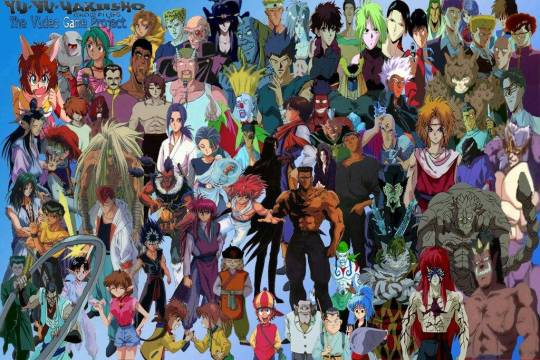
This eventually becomes a story about the demon world and those demons wouldn’t come across as particularly scary/other if you begin the story with equally strange looking humans. Or even just “I don’t see people who look like that walking down the street” humans. Alongside many themes, there’s a contrast at work here. Yusuke stepping out into a stadium full of demons who despise him because of his species hits home when he is so clearly distinct from them. Suddenly, his normal is abnormal.

Once the ball gets rolling, Yusuke’s looks are constantly in contrast with both his environment and his inner self. He looks like a scary thug but then unexpectedly saves a life. He looks like an average human but is actually the strongest among a group of scary-looking demons. He looks like this badass spirit detective who everyone assumes with have an equally badass spirit beast but, uh...

Oh my god that’s a precious baby. By the time our cast is family and everyone accepts that Yusuke looks scarier than he actually is or ever was - once the core group is made up of not just humans but demon loving humans who are equally soft - we turn it all on its head again and reveal that Yusuke has demon blood. For the first time he looks as strange and powerful as he is. Yusuke’s normality is done away with the second he’s fully accepted his place in these worlds, throwing everything back into chaos.

Yusuke’s demon form becomes even more foreign looking when he’s being controlled by his ancestral father. The above is a Yusuke who is still Yusuke and in many respects the design reflects that: natural hair color, human body, tattoos easily covered up with a shirt. When he’s gone full Mazoku though, something dangerous, the white, wilder hair and change to his expressions ensure we read him as something feral. For the first time in the series Yusuke is truly the dangerous creature he’s pretended to be since his principal was running after him at school.

As a side-note about character costumes, we see this emphasis on normality in their outfits as well. Obviously a story like RWBY is limited by how much time/money they have for animation, but it nevertheless has an impact to see the group almost constantly in their battle gear. They’re never not the main characters of an action-fantasy show, not even while just out around town with no expectation of entering a fight.

In contrast, Yusuke and Kuwabara are often animated in everyday clothing that remind us that they’re really just teens trying to live their lives outside of this crazy nonsense. Kuwabara wasn’t even formally hired for all this! The cast wears sweaters and jackets while out and about. More formal clothes for special occasions. Jeans and t-shirts when they’re unexpectedly caught up in a fight because, you know, they’re not ready for battle every second of every day. They’re drawn like normal folks because, outside of the ring, they are.
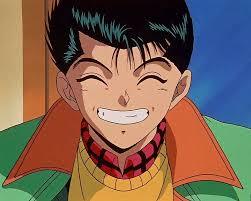

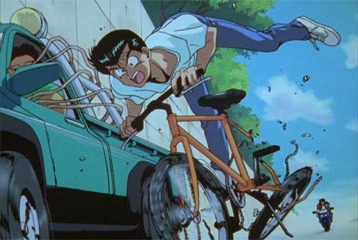

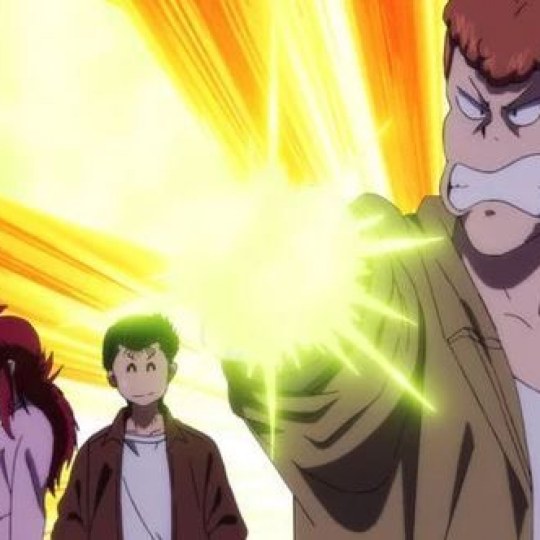
(We’ve also got a lot of parallels between Yusuke and Kuwabara’s civilian clothing, visually reminding us that they’re far more alike than they might be willing to admit.)
Despite often changing outfits, the group maintains a basic color pallet that makes them recognizable, yet it’s also not so limited that they appear strange for sticking to one (1) color for the entire time we know them. Yusuke, like most people, is drawn to particular colors, mostly greens, yellows, and blues, so each time we see him he’s familiar while also being distinct from the last time he changed.



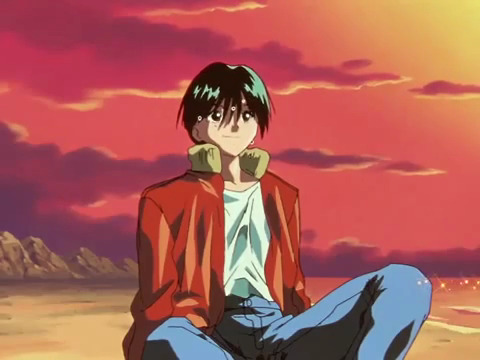
Hiei, as someone who initially wants nothing to do with anyone else and relies on assassin-like speed to take out his enemies, is dressed almost entirely in black. Without that bit of white in his scarf/hair you’d lose him in the shadows... which is the point.

When he opens up and actually becomes friends with the team, his color pallet starts opening up a great deal too.
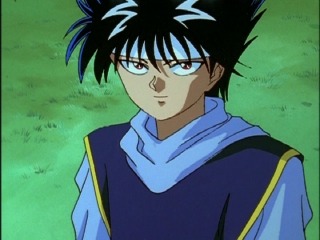
And we’re shown all the little changes he starts incorporating that speak to his growth: his Jagan eye, a bandaged arm hiding his Dragon of the Darkness Flame, the necklace connecting him to Yukina.

I’ve blathered on about the outfits enough but as a quick final note: EVERYONE WEARS APPROPRIATE FIGHTING CLOTHES.
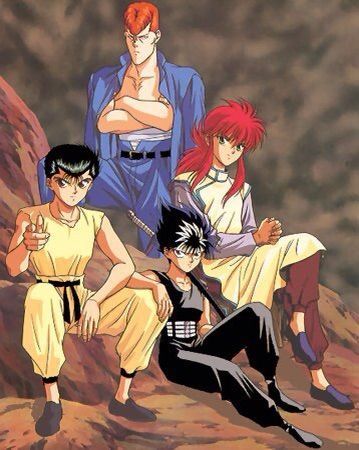
No one (even the women to my recollection) wear heels. Everything is loose-fitted and looks easy to move in. They’ve got sensible belts, bandages if they need them, and... that’s it. No unnecessary bells and whistles that distract from what’s supposed to be the story’s real draw: good fights and good characterization. Even the more elaborately styled characters (usually) look like they chose their outfits practically first and for the aesthetic after. At no point do I recall watching this show and going, “WHY would you wear that to a fight??”
Anyway, back to the designs.
The exceptions to either side of these extremes - from human normal to demon monstrous - are Genkai and Kurama, both of whom straddle the line. Genkai is someone who has pushed her spirit and body far past the norm. She’s the first human we meet who truly goes beyond that normality, even if you don’t immediately realize it. Her pink hair (such a soft color in her old age it’s not at all distracting) is a slight hint that something isn’t quite right with her. She’s obviously human... but not a normal human. Not anymore.
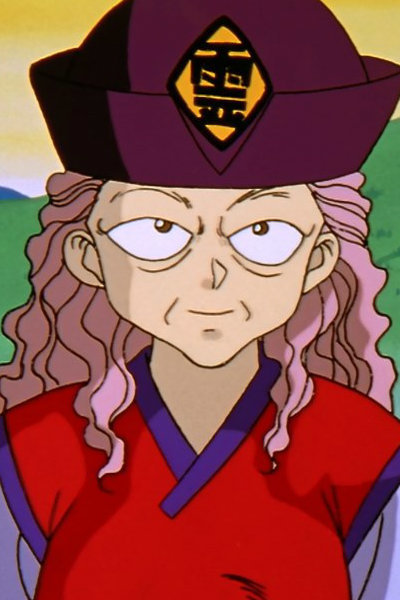
Those unnatural looks are emphasized in her youth when she was at the height of her power.

Genkai as a young woman has vibrantly pink hair (a bright pastel like Botan’s), a softer face, and far more emotive eyes. She looks ethereal, which fits not just her own journey to power but Togoru’s as well. Her story is intimately tied up in what that power does to the human body/soul. So Toguro starts out like this

a pretty normal looking guy who is on the far end of what the human body is naturally capable of. He’s buff as hell, but not so much that it looks unreasonable. I’ve seen body builders bigger than him. He’s the average (dehydrated...) MCU superhero. However, he ends up like this
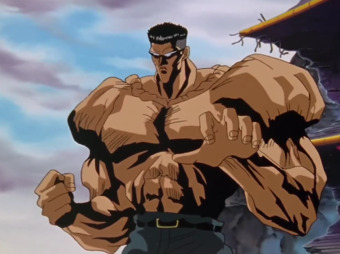
In Togoru’s case his abnormality is explicitly presented as grotesque. Rather than giving him a cool looking characteristic that’s clearly supernatural (blue hair, an extra eye, curly horns, etc.), we’ve taken a human characteristic (muscles) and expanded them to an unnatural degree. He’s got some uncanny valley shit going on.
Paralleling Genkai, we likewise see Kurama subtly standing out among his human allies.

He’s a demon in a human’s body. By in-world logic his appearance should be just as normal as anyone else’s, but a bit of his true nature shines through. His hair is long in a style not popular in YYH’s Japan. His red is far less of a natural shade than Kuwabara’s. He carries himself with the air of someone who is ancient, because he is. His human design deliberately reflects his true demon form so when that’s finally revealed we still recognize him as Kurama.

(Same sort of work with Hiei’s demon form.)
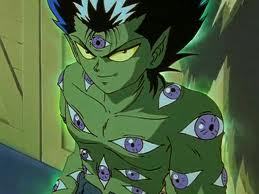
When we look at the cast together we have an immediate, visual impression as to who is normal and who is not - and those assumptions are embedded into the story. Yusuke is someone you’d overlook in the crowd, but he’s the most powerful. Kurama is clearly other in some way, but he’s desperate to live an average, human life. Kuwabara is designed to look and move like the fool and a lot of his development (his and others’ in relation to him, really. Like Hiei) is built around respecting him despite those looks. Hiei is tiny but will kick your ass. Genkai is tinier and will kick your ass worse.
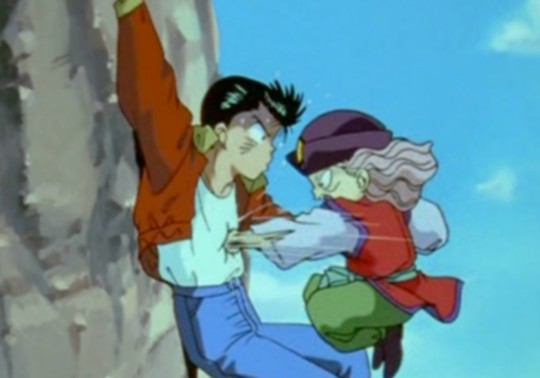
Her size combined with her age - combined with her status as Yusuke’s teacher - is a continuous reminder not to judge power by looks alone. Don’t underestimate your opponent and get overconfident (a major flaw of Yusuke’s). Know that you still have a LOT to learn about the world. That woman you assume is just a rude grandma? She’s going to break your expectations over and over and over again.
Speaking of size, that’s a major aspect of Koenma’s design as well. When Yusuke learns he’s meeting the head of the underworld he starts picturing a massive, demonic beast who (sensing a theme here) looks the part of a supernatural ruler. Seeing Koenma for the first time - an adorable toddler-like being - is an absolute shock.

It’s a gag for the audience, but it’s not just a gag. Due to his looks Yusuke is unable to take Koenma seriously, despite knowing the power he holds.

Which, even more-so than arrogance, is Yusuke’s greatest flaw throughout the series. He doesn’t take school seriously. His death seriously. Ruler of the underworld seriously. His teacher seriously, etc. Yusuke constantly acts like he doesn’t care, throwing basic respect and effort in the face of whatever authority figure is desperately trying to keep him from self-destructing. He’s on the receiving end of multiple speeches throughout the series (mostly from Genkai) that boil down to, “Care about something, dammit. Take this seriously!” and when he does it’s GREAT. It’s a moment of growth we’ve really built to in a hundred different ways, including how he reacts to others’ looks. Koenma’s design feeds directly into the primary flaw Yusuke is working to overcome. How will he go from a delinquent laughing in the face of the most powerful being to someone multiple worlds can put their trust in? Design assists with that.
When Yusuke does respect Koenma (even if he still insults/teases him because that’s just an ingrained part of Yusuke’s personality) Koenma’s appearance can change. It’s no longer serving its original function, so he evolves into a very good looking young man (with references to Tuxedo Mask to emphasize those good looks) that just... happens to still carry a pacifier.


A pacifier that is revealed as an incredibly powerful weapon that will help save the world. Again: don’t judge anyone or anything solely on their looks. They’re never precisely what you’d assume they are based on your first glance - with the exception of minor villains whose looks serve only to convey their villainy:
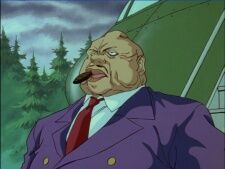

For everyone else, looks are complex. Two of the most different looking characters (color-wise anyway) are actually siblings, their contrasts reflecting both differing cultures and the emotional distance between them.

The scariest looking monsters are just paper-pushers. It’s the handsome humans you should watch out for.
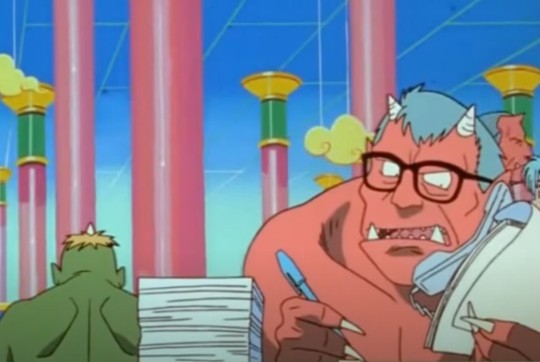
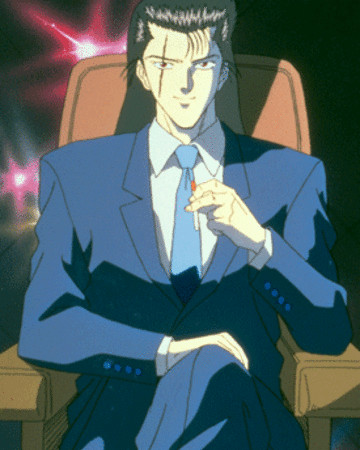
And this is our hero, a man charged with protecting three worlds.

I could say SO MUCH MORE but this is already disgustingly long so basically YYH (I think) does a great job of:
Crafting characters that are distinct but not different for the sake of different. They always feel like they belong to their individual worlds and adhere to whatever “normal” is by those standards.
Tying character looks really closely to the show’s themes and individual growth. Which, frankly, is something I think all good character design should do.
It’s not nearly as flashy as other anime... but YYH knows what it wants to accomplish and went about it beautifully. Catch me still weeping over this show fifty years from now.
Peace ✌️
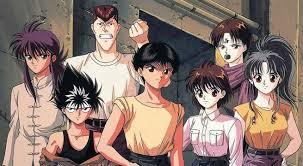
#Anonymous#YYH#Yu Yu Hakusho#mymetas#for the record#I'm not trying to hide my response or anything#(lol)#tumblr would just NOT let me put the read more anywhere else#why are you like this tumblr
93 notes
·
View notes
Text
Finally working my way through the main story of Pokemon Shield. Yes it has been a long time. What can I say, Pokemon-as-sports-analog is probably the least interesting aspect of the franchise to me. It’s cool if its your favorite part but its not my cup of tea. I’m here for the magical reality-bending creatures that just exist as a natural part of this strange world. And the creature design.
Anyway... Chairman Rose’s motivations really seem emblematic of trying to keep the villain sympathetic and understandable while also giving the hero every reason to stand against them... without the investment in giving it the nuance it needs to work.
Rose awakens a dangerous power with the goal of stopping a crisis, but don’t worry the crisis is 1000 years in the future and not really an issue right now? That’s... something. But that something isn’t nuance on its own.
Rose ultimately wanting to prevent an energy crisis but trying to solve the problem in a reckless way? That on its own works. Make the crisis more eminent (even in the next 20-50 years if you must, since at least its still within the lifetimes of the characters involved) so his push to do something reckless that endangers others is more understandable. Sympathetic villain that still has to be stopped? Check. Done. You’re good.
But that makes Leon choosing not to work with Rose and the player trying to stop him problematic. There’s still the looming crisis. Can’t have that, right? And having another solution magically present itself might seem too convenient, so shove the crisis so far into the future that everyone else looks sensible for not worrying about it and Rose look ridiculous.
Yes, you could keep it and still make things work. How would it go with only minimal changes? Quite well, actually. Give Rose a few lines about how putting things off means that problems sneak up on you, about how much what we do today affects the future, or even about the concern that people of the future won’t try to fix the crisis so stopping it now is better. Just a few lines of dialogue and then there’s a legit conflict between Leon and Rose about the best course of action. Draw parallels to our own energy issues and how putting things off has made things worse. But again, that might make Leon look bad and we can’t have that, so I guess leave that for fans to fill in on their own.
You could change it a bit more. Have Rose want fame. Motivate him with the prospect of being remembered in the future as the guy who solved the crisis. Immortality through fame is a fun motive to play with and he’s still trying to be a hero and could tie in thematically to the way old legends are remembered or misremembered over time. He can still think he’s the good guy but the reckless method instead of investing his rich CEO money into studying energy efficiency would fit a bit better.
Idk. I guess all I’m trying to say is that it feels like a first draft of a story rather than one that a company full of people could have made a bit more impactful with just a few changes? Like, they want their villains to be more nuanced but also have to shove out new games because capitalism so they can’t take the time to actually explore it.
Maybe I’m being too harsh, but I feel like just changing a few lines of dialogue could have helped it seem less like a silly balancing act and more like a nuanced story. Honestly, the only reason it bugs me is because of how close it came to having all the ingredients but just didn’t.
#I'm probably being too critical#but really a few lines to make 1000 years from the present actually feel concretely important? that's all I'd need to vibe with this plot#that's it#out of story I can justify why Rose sees 1000 years out as something urgent#in story there's not the work to make it part of the theme#emeraldmew is rambling today#it just feels so 'first-drafty'#that said... keep up the eldritch abomination pokemon designs like eternamax eternatus
3 notes
·
View notes
Photo

Dream Chasers.
Mark Harris and Alicia Malone—two of the hosts of this month’s TCM Film Festival—tell Jack Moulton about Nichols and May, West Side Story, classic lockdown discoveries, and the films that make you feel like everything has changed when you walk out of that cinema.
For a second year in a row due to the Covid-19 pandemic, the TCM Classic Film Festival is being hosted virtually. Its program screens across TCM and HBO Max from May 6 to May 9. The festival, which began in 2010, was held at Grauman’s Chinese Theater and the nearby Egyptian Theater in Hollywood, a move designed to allow classic movie fans to retread the footsteps of glitzy premieres from the glamorous past.
Ahead of Steven Spielberg’s upcoming remake, the festival opens with West Side Story’s 60th anniversary screening, featuring new and exclusive interviews by living legends Rita Moreno, George Chakiris and Russ Tamblyn. The complete festival lineup includes classic programming and talent highlights, from Michael Douglas introducing his Best Picture-winning One Flew Over the Cuckoo’s Nest to Scorsese on Goodfellas, to a comedian-heavy table read of Edward D. Wood Jr.’s infamously bad Plan 9 From Outer Space.
Journalist and author Mark Harris, who published the biography Mike Nichols: A Life earlier this year, is presenting the 1996 American Masters documentary Nichols and May: Take Two, covering the Oscar-winning director’s legendary comic partnership with Elaine May. It features iconic sketches that will recontextualize the way you think about Nichols if you thought his career started with Who’s Afraid of Virginia Woolf? and The Graduate.
TCM host, feminist cinema expert, Australian expat and Letterboxd member Alicia Malone is also a presenter at this year’s festival. (She admits she’s slacking on her Letterboxd logging this year, but used it to track her viewings over lockdown, topping over 500 films.) Neither Harris nor Malone have been able to go to the cinema since they closed over a year ago, but both are eager to return to their local arthouses in Maine and the Upper West Side of Manhattan as soon as they’re ready.
We caught up with Harris and Malone shortly before the festival commenced for a classic edition of the Letterboxd Life in Film.

‘The Poseidon Adventure’ (1972).
What’s your fondest memory of seeing a film in the cinema? Mark Harris: This is embarrassing, but for me it’s The Poseidon Adventure. At the time, my parents were a bit stricter than other parents so the other kids were already getting to see so-called ‘adult’ movies. The Poseidon Adventure was the first ‘not-kids’ movie that I ever got to see in a theater and at the age of eight, I immediately thought ‘well, clearly this is the best movie of all-time’. Everything in it was new information to me, such as how adults talked to each other and Stella Stevens playing a prostitute—I had no idea what that was. I found it so scary, I believed everything I saw on the screen. The joy of taking in something I hadn’t seen before has never left me.
Alicia Malone: It would probably be seeing Amélie. I was living in Canberra but my older sister had moved to Sydney, which to me was the big smoke, I really wanted to live there when I grew up. I got to visit her by myself and stay in her flat which she was renting by herself and it seemed so cool. She took me to the local arthouse cinema where Amélie was playing and I was so swept away. I know that film gets a bad rap now for being overly sentimental and quirky, but I just felt like I was being seen. I had such a kinship with the character of Amélie because she’s a dreamer, always in her own head and that’s how I was. I was always comparing my life to movies and playing movie scenes in my head. I remember walking out of that cinema and it felt like everything had changed—the color was brighter, it was special.
MH: We have to talk Turner into an Amélie-Poseidon Adventure double-feature!
AM: What a double! That would be amazing.

John Garfield and Ida Lupino in ‘The Sea Wolf’ (1941).
Which classic films that you discovered during lockdown had a major impact on you? MH: I wanted to dive into some directors that I really didn’t know well so I started watching all the Luchino Visconti movies, because Italian cinema is not my strongest area. That was an incredibly rewarding experience. I also saw the big seven-hour Russian War and Peace, which completely blew my mind. Those were probably my big pandemic discoveries.
AM: Something I really loved was getting to do the TCM Star of the Month for John Garfield because he’s such an interesting character and was a pre-cursor to Marlon Brando, Robert De Niro and those types of method actors. I’d seen him in various films—such as The Postman Always Rings Twice—but I’d never sat down to watch a lot of his filmography and learn more about his personal story. To see films like The Sea Wolf and Body and Soul, I really gained a newfound respect for him as an actor. You can see some of the beginnings of that kind of tough-guy, everyday-man archetype with a brilliant actor putting his emotions right there on his sleeve.
MH: I should also say that the Women Make Movies Festival was huge for me. All those movies are on my DVR and I’m still going through them and discovering them. I recorded everything and that was and continues to be a gigantic education for me.
AM: Yes! Thanks for that reminder. That was such a fulfilling experience to get to be one of the hosts on that with Jacqueline Stewart. What was so brilliant about Mark Cousins’ documentary is that there are so many clips of films that you think how have we not seen this? How are we not studying this film? How do we not know about this particular filmmaker?

Meryl Streep and Jack Nicholson in ‘Heartburn’ (1986).
If you could only pick one, which is the most overlooked film by Mike Nichols? MH: The most under-appreciated film to me is Heartburn. That was a real rediscovery when I was working on the book. I remember liking it, but I didn’t remember how sharp the performances were, how funny the comedy was, and the really acute social observations. I was so surprised when I was coming across the reviews—almost all of which were by men—and all of them said some version of “Why is he wasting his time with this? Why would he tell this woman’s story? Why doesn’t he tell the other half of the story?” Surely no-one would leave this character unless she gave him a good reason to leave! It was really shocking to me how dismissive and contemptuous a lot of the critical reaction was. I’m so happy that I’ve gotten to stick Heartburn under a lot of people’s noses because it’s a movie they seem to be really liking once they find it.
AM: I’m obviously not as deep into his filmography as Mark is, but I have to agree that Heartburn is a film that I can’t believe has been so overlooked. I came to that movie through Nora Ephron, who I just adore. [Heartburn is adapted from a semi-autobiographical novel by Ephron.] I rewatched it recently and I was blown away by it. Of course, Meryl Streep is amazing, but just getting to be in those characters’ worlds again and watching it after I had listened to the audiobook—which features the voice of Meryl Streep—about a year ago added a whole new experience. I loved how in her book how she has all these recipes dotted through it that you see in the movie as well.
MH: That’s one of the great audiobook readings of all time. It’s great to listen to [Streep] do that.
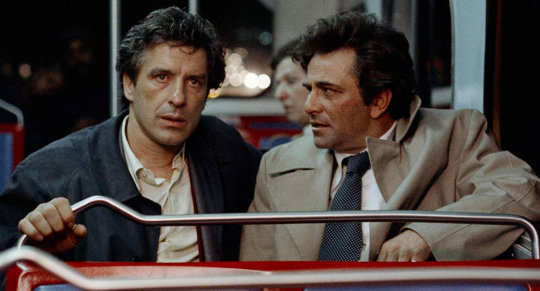
John Cassavetes and Peter Falk in ‘Mikey and Nicky’ (1976).
Where do you recommend film lovers start with Elaine May? MH: It’s only a four-movie body of work as a director so I think it’s perfectly fine to go in chronological order. A New Leaf is fantastic and feels 100 percent her. You really get a great deal of her sensibility in that movie. I would just start there and go to The Heartbreak Kid and then to Mikey and Nicky, which is not the place to start but is a fascinating movie, and then you’ll be ready for Ishtar.
AM: See, I would say Mikey and Nicky straight out of the gate.
MH: Really?
AM: I love subverting expectations of what a female director can do and that is such a masculine movie. It’s a film that you wouldn’t expect for a female director to make. I love the back and forth, the rapport between [Cassavetes and Falk]. I find it really compelling and exciting every time I see it. So I say, go hard, go in with Mikey and Nicky then, yeah, A New Leaf and The Heartbreak Kid, but maybe skip Ishtar.
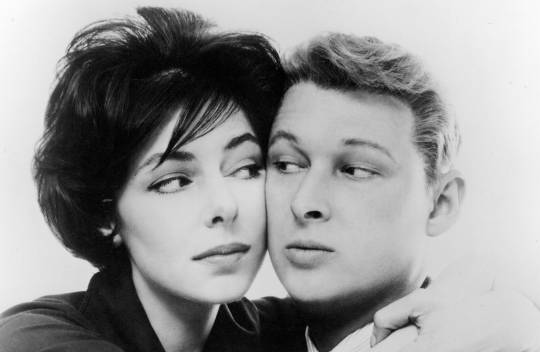
Iconic comedy duo Elaine May and Mike Nichols.
Thinking of Nichols fleeing to New York City from Germany, and Alicia moving to Hollywood from Australia, which ‘American Dream’ film resonates with you the most? AM: This answer is going to sound quite cheesy since it was a recent film: La La Land. I understand all the criticism about it, I agree with it, but I don’t care. I feel like it was made for me as a redhead in Hollywood, chasing her dream, and coming up against all the obstacles. I also love Singin’ in the Rain, which I know is not necessarily strictly about the American Dream but is about Hollywood in general. That is a film that really started the idea of moving to Hollywood as a young kid. It’s the idea of a magical place where you could do anything and make your dreams come true and have dignity—always dignity.
MH: This time I’m going to go hard and dark and say the first title that occurred to me, which is The Godfather: Part II. It’s a great immigrant story, though it’s a strange version of the American Dream. The whole saga is about coming to America, becoming an American, and deciding what American values are.
AM: I should say that during our TCM Film Festival on HBO Max, we have a section on immigrant stories. We have America, America, which is a great one by Elia Kazan, and Stranger Than Paradise, which I would recommend as well. It’s a warped view of the American Dream but I love the way they think they get rich and all their dreams can come true. Also Black Legion, which is a darker version of the immigrant story with Humphrey Bogart going to the darker side of ‘foreigners should not take American jobs’.
MH: I’ll just throw in a plug for another Mike Nichols movie, Working Girl. He really saw that as an immigrant story—the first shot is of the Statue of Liberty, even though they’re [emigrating] from Staten Island! I think Mike thought it was as distant of a land as the old country, I’m not sure he spent a lot of time on Staten Island.

Katharine Hepburn in ‘Woman of the Year’ (1942).
What are some of your other problematic faves? The classics we acknowledge have not aged well, but you love anyway. AM: I think My Fair Lady is one of those. I’m a sucker for make-over movies despite all of their problematic ways of showing how women need to change if you don’t fit into the mold and you should sand down all your edges. But I get worked up in the whole transformation myth and making your life better. Even though it’s got Audrey Hepburn and you want to see Julie Andrews in that role, My Fair Lady is still one that I enjoy and I can see all of the problems with it.
Another one, that we featured during our Reframed series on TCM, was Woman of the Year, which is a great example of one of those women’s pictures that, as Professor Jeanine Basinger has pointed out, is so empowering for most of the movie and then in the last five minutes it undoes everything. It’s still a great film to watch when you want to get ahead of feminism and see Katharine Hepburn in a wonderful role, but you just have to ignore the breakfast scene at the end.
MH: I was just talking the other day to some people about the movie Network, which is one of my all-time favorite movies, but if you look hard at Network, it’s very possible to read that as a story about a woman who can’t be a professional in a workplace without hollowing herself out and becoming sort of less-than-human. [Diana Christensen] is talked about terribly by the other characters and you’re supposed to learn a hard lesson about what a monster an ambitious woman can become and that does not hold up well. It’s also a movie that features some of the wittiest dialogue and some of the greatest performances of any movie of the 1970s and I’m always going to love it for that.
AM: That’s such a trope, isn’t it? The ice-cold career woman.
MH: Right, and whoever did it better than…
AM, MH: Faye Dunaway!
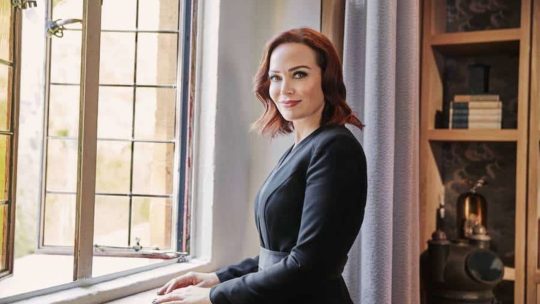

Alicia Malone, Mark Harris.
Which coming-of-age movie character did you find the most relatable? AM: For me, it’s Velvet Brown played by Elizabeth Taylor in National Velvet. I watched that over and over as a child when I was obsessed with horses. It was so inspiring as a young girl to see another young girl chasing her dreams—pretending she’s a boy that doesn’t speak English to win the Grand National—particularly at the time when I grew up in the 1980s, when so many of those films for kids were about young boys achieving their dreams.
MH: Haven’t seen it in a long time, but the Peter Yates movie Breaking Away meant a lot to me when I was a kid. The idea of chasing something that means something to you but trying to reconcile what your parents thought about it, and how to balance your own dreams with the expectations other people had for you. I think that’s a really lovely movie.
I still think about those performances by Dennis Christopher, Dennis Quaid, Daniel Stern and Jackie Earl Haley, and of course Barbara Barrie and Paul Dooley as the parents. That movie landed right in my heart the first time I saw it. I’m almost afraid to go back now, I don’t want it to have turned into one of my problematic faves! I want it to be one of my faves.
If we could gift every Letterboxd member two hours of HBO Max to discover one film from this year’s TCM Classic Film Festival lineup, which film would you want it to be? (My pick is Bless Their Little Hearts.) AM: A film that I just adore is Cléo From 5 to 7 by Agnès Varda. She was working in the French New Wave and arguably made the first movie ever in the French New Wave. It’s one of those great movies that is close to real time as possible—it should be Cléo From 5 to 6:30 really, because it’s an hour and a half. It’s so inventively shot and edited. I’ve done the walk that she did in Paris, I’ve tried to map that out and copy Cléo. I want more people to see it and discover it.
MH: My husband [playwright and screenwriter Tony Kushner] recently finished writing a new version of West Side Story for Steven Spielberg that’s going to come out at the end of the year. I think I would like to gift everybody the first version of West Side Story, which opens the festival, because you have to start there. It’s a beautiful movie and I think it’s a really instructive thing to see how this story was told in 1961 versus how it’s going to be told in 2021. Also, it’s two-and-a-half hours so if we’re only gifting people two hours… they’re not going to see the ending and they’re going to have to go to the new one to find out what happens!
Related content
Follow Mark Harris, Alicia Malone and TCM on Twitter for updates on TCM Classic Film Festival 2021
Watch the TCMFF West Side Story cast reunion, May 6 at 6pm ET
A Letterboxd list of all the films mentioned in this interview
Follow Festiville for all Letterboxd festival coverage
Follow Jack on Letterboxd
#tcm#tcmff#tcm film festival#hbo max#alicia malone#mark harris#tony kushner#elaine may#mike nichols#nora ephron#steven spielberg#west side story#letterboxd#letterboxd life in film#classic film#classic movies#old hollywood#hollywood glamour#hollywood glamor
3 notes
·
View notes
Text
Capsule Reviews April 2021
A few of the things that I've been reading over the past couple of months. I surprised myself when I noticed that most of these were indie books, but that's probably because all of my needs for big dumb superhero comics are currently being more or less covered by the material I'm reading for my podcast, Regarding Spawn. Anyway, here's some review.
Grenade by Will Kirkby
Grenade is in many ways an art showcase, a vibrant little volume centered on a world somewhat along the lines of Shadowrun, a cyberpunk setting with fantasy elements. The story focuses on a main character somewhat typical for the cyberpunk genre, a traumatized transhuman war veteran turned cop, haunted by their memories as they are drawn into a web of conspiracy tracing back to their wartime experiences. The story is hardly surprising, but this is a book that you read for the texture, not the plot. Grenade is gorgeous, jam packed with detail in the maximalist tradition of artists like Geoff Darrow but with an angular, punk edge, and the world building and concepts are all fun and have great hooks. There are certain ideas introduced at tossed aside that I wished to see a bit more of, but overall it's a very satisfying cyberpunk flavoured romp that would be well worth it for the art alone.
Home Time Vols. 1-2 by Campbell Whyte
Stand By Me by way of Over the Garden Wall, if put in reductive terms, I picked up the conclusion to Campbell Whyte's stellar first volume of the series and recently had the chance to read them back to back. They're excellent, maybe some of the best comics I've read this year, stellar YA material with a bold, experimental style and great storytelling. Centering on four friends about to graduate from middle school and go their separate way, the characters are suddenly caught up in a strange fantasy world with no way back home and the story focuses on how they cope with this as they gradually learn more about the world. The kids all feel like kids (or at least how I remember being a kid), the worldbuilding is really unique and off-kilter, fleshed out by loads of journal inserts ranging from photos to diary entries, to a handmade encyclopedia right out of Gravity Falls. The art is stellar, sticking to a general cartoon-y aesthetic but jumping back and forth through various styles of coloring and rendering with each viewpoint character, including sections rendered in a pixelated style which evokes a great deal of nostalgia for me as someone who grew up reading sprite-based webcomics. Some of the plot beats might not surprise you, but others probably will, and I can't recommend checking this out enough.
The Grot by Pat Grant
Another Australian book, not that I've been on a kick or anything. The Grot is quite excellent, a sort of "low post-apocalyptic" story set in a world littered with the detritus of our own. The world building is a treat, lived in and recognizably plausible but strange; cars and boats are powered by low wage laborers on pedals, electricity and running water are unheard of, cholera runs rampant, and anyone and everyone is partaking in an algae-based gold rush. The Grot is very much a gold rush story, and indeed about the biggest criticism I could make about it is that it could just as easily be set in any given historical gold rush with little effect on the narrative, the conceit of a post-lapsarian world is hardly taken advantage of, but then perhaps that's the point, "the more things change, the more they stay the same" and all that. The story itself is a classic one of ambition and confidence games, following two young brothers who arrive in a boom town with plans to be the only ones not getting suckered. The artwork and colors are vibrant and distinct, a loose, cartoonist's touch which nevertheless manages to make everything look distinctly real and absolutely filthy. Everyone is ugly and dirty, dressed in distinct clothes, cutting distinct profiles, looking real and alive, even if Grant doesn't pursue a photorealistic style. I'd recommend it for those looking for something different from the standard action oriented fair coming out from most major American publishers, but not sold on art comics. The Grot is a great read packed with story and personality.
Sazan and Comet Girl by Yuriko Akase
Coming out in 2018, right in the meat of Wife Guy culture, and preceding the rise of himbos by two years, Sazan and Comet Girl is a book well suited to the moment. It's about a nice, not entirely bright young man pursuing a Cool Girl across the stars as they fall in love. It's also, in fairness, Sazan and Manic Pixie Dream Girl in some ways, though it holds off the worst of that genre by characterizing Sazan primarily through the lens of sincere enthusiasm and support for his much cooler, more powerful love interest. It's a distinctly fun, peppy book, that's really gorgeously rendered, with full lush water colours on every page and a design sensibility firmly in line with retro-anime. It's not entirely without points to criticize, the titular Comet Girl spends the entire book rarely wearing more than bra and a pair of brave Daisy Dukes, and the trick employed throughout the final sequence of the book, which takes up the entire back half (the pacing is also a touch off) to get the whole universe cheering for the heroes is a little cheap. But overall Sazan and Comet Girl is really charming, it's cute, incredible to look at, just a little horny, and a fun adventure. I heartily recommend it.
PTSD by Guillaume Singelin
I'd had this sitting in my To-Read pile because I wanted to take some time between reading Grenade and this book, since there are quite a few superficial similarities between the two: they're both sci-fi adjacent, they both star traumatized veterans, both are lushly rendered by indie cartoonists, so reading them back to back would have felt like a disservice. For the record, they're ultimately not similar at all. PTSD is the story of Jun, a traumatized war veteran living on the streets of an unidentified city, pushing away all attempts at help or community as she slowly spirals downward, killing drug dealers to fuel her addiction to pain pills. One thing that stands out to me about PTSD tonally and about its main character is that it's willing to let Jun be really unpleasant in a meaningful way. Jun isn't an "asshole" because she's too much of a hard drinkin', hard fuckin' badass, she's an asshole because she's so deeply traumatized that she lashes out verbally and physically at anyone who comes near her. It feels unglamourous and real in a really enjoyable way.The art is also a revelation, it doesn't quite cross the line into Geoff-Darrow-insired visual maximalism, but every panel and ever inch of the pages are packed with lovingly rendered detail. Singelin's drawing style tends more towards cartooning than pseudo-realism, in a way that makes the charming moments utterly charming and the brutal moments appropriately shocking. I have some minor issues with the ending, the story kind of cuts out without really delving into the messy implications and the long tail to Jun's conflict with the drug dealers, and there's a touch of action movie logic in that the main character is alone among the veterans in her trauma having left her as a kind of towering badass rather than one of society's victims, but putting those aside PTSD is a really satisfying story about trauma and community.
1 note
·
View note
Text
Frankenstein: A Product of the Times
Released in 1931, Frankenstein clocks in at the oldest film reviewed on this blog. Eight years before The Wizard of Oz would hit theaters, Frankenstein was released near the dawn of the ‘talkies’, a few short years after 1927’s film The Jazz Singer. Frankenstein came out in a golden age for Hollywood, where filmmaking was being impacted by new inventions, getting bigger and better as more films were made.
All of this is cool, but this isn’t an article about the history of movies. It’s about the times that Frankenstein was born in.
1931 was a tough year. Prohibition was still in force, and at the time, The Empire State Building was the tallest building on Earth. The Great Depression had just started, and with it came a drop in the morale of the entire nation. While sabers weren’t yet rattling quite so loudly in Europe, things weren’t spectacular either. It was the job of the movie business to keep the people’s minds off of it. As a result, many films of the 1930s were full of lighthearted movies about beautiful, rich people having a good time. Movies were loud, carefree, optimistic, stuffed with glamour and glitz. People didn’t want darkness. They wanted light.
All of this may not seem like important information when watching a film made almost ninety years ago in the present day, but in the realm of analyzing film, this stuff is very important. In order to understand Frankenstein, first we have to contextualize it.
Hence this article.

We’ve discussed it a hundred times before: No film is an island. Every movie ever made, every story ever told, is a product of the people who created it, people who are in turn influenced by the culture. Every song, movie, book, TV show or magazine is a product of the times, and shows it, even a ‘timeless’ classic like Frankenstein. No matter how far removed from the culture by location or time, every film we look at carries the signature ideas, designs, acting style, archetypes, stories and special effects of the time of its creation.
The unfortunate result is that the test of time doesn’t always allow films once considered classics to pass without blemish. Some movies age better than others.
So, which is Frankenstein?
It’s actually a really hard question to answer.
Unlike plenty of the other examples we’ve looked at previously, Frankenstein is hard to pin down on a first viewing by way of actual story design. The film is in black and white, sure, and the audio and visual quality speak to earlier cameras and sound-design, but when it comes to actual visual storytelling, it’s very hard to tell when this film actually is from.

Most contemporary movies of the 1930s looked like films of the 1930s. People dress or talk like the decade a film was made in, that’s to be expected. Some films, like Gone With the Wind, worked very hard to make sure that the film looked like the time period it was set in, but Frankenstein, while not being the 1930s, isn’t really any other time, either.
The film’s setting is a classic example of Anachronism Stew. Electricity brings the creature to life, but there’s public hangings. The university that Fritz steals the brain from seems contemporary to 1931, but there are no phones, no trains, no cars, and no guns. (The mob chases the monster down with pitchforks and torches, remember?) The people of the town that Frankenstein is from seem to be living several decades previous to when the film is actually set.
Equally odd is the fact that there’s no idea when this is set. Of course, the characters speak English, and several of the actors hail from England, but the existence of a Burgomaster seems to indicate Germany. There is nothing in dialogue or geography that pinpoints where or when this film is set.
As such, this removes one of the classic arguments for films being outdated: the simple evidence of the time a film is made in.
Unfortunately, the term ‘dated’ is often applied with a negative connotation to films that are discernibly set in a certain time, viewed as less enjoyable to any viewers who aren’t currently in the culture that created it. This word is used for a film that isn’t considered to have ‘aged well’, and the criteria for such a judgement could be anything from hairstyles to slang of the era.

In terms of this test, no, Frankenstein is not dated, not in the slightest. But that’s not really the criteria we use here.
The question of whether or not a film is ‘dated’ has little to do with the fact that people look and sound like they are in the decade that they are in. Rather, it has more to do with the idea that the film’s ideas and worldviews have aged poorly, how certain issues or character types are viewed or utilized is what truly dates a film, more than any outdated slang term or hairstyle.
With that in mind, again, I ask the question: ��Is Frankenstein dated?
Honestly? Not really.
Obviously, as I mentioned before, the look and sound of the film from a technical standpoint puts the film firmly, and obviously, in the 1930s, and some might argue that the staging of certain shots, filmed as set stages as in a play, point to early tactics of film-makers. While all of that is true, it doesn’t change the fact that the core story, the story of Frankenstein, is never going to be dated.

The thing is, Mary Shelley’s Frankenstein novel was already over a hundred years old when this film was made. The original story, the kernels of plot that are inherent to each version of the Frankenstein tale, is immortal. And that translates pretty well to the film.
Like I’ve said previously, Frankenstein is clearly a movie from the 1930s. It comes across as an old movie, which makes sense, because it is. Ninety years have passed since this film first came to life, and it makes sense that some things have changed. More modern interpretations of Frankenstein would probably give Elizabeth a bigger role, for example. But as I’ve said, there’s a difference between being deeply rooted in changing ideas, and simply showing its age.
Frankenstein is the latter.
Frankenstein is one of the original monster films, one of the grandfathers of the modern horror film, and that actually adds to its timeless nature. We’ve seen these scenes hundreds of times, in different films or other mediums. Even if you’ve never seen the film, if you sit down in front of Frankenstein, you instantly recognize these characters, the setpieces, even specific scenes, because they’ve been done so many times since. Even still, it saps none of the original electricity (ha!) of the original sequences. It doesn’t matter if you’ve seen a hundred parodies of Frankenstein raising his creation from the dead, the scene from the 1931 film still possesses an incredible spark that, honestly, most of the film has.
There is nothing in this film that points to an ‘outdated’ sensibility, because the ideas that it presents are still wrestled with to this day. The ideas that Mary Shelley first wrote about in 1818 are still in use in science-fiction to this day, the fateful idea of man’s destruction at the hands of our own creations, or of humanities inability to accept limits, or of the socialized fear of what is ‘Other’.

Frankenstein is a tragic, spooky, intriguing and compelling story that has remained steadfast this long because people still get into this story, and these characters. In my opinion, a movie is timeless not based on whether or not you can tell what decade it was made in, but by how well it has endured, on how well people can enjoy it long after the culture has changed. With that criteria in mind, Frankenstein holds up extremely well.
Frankenstein has lasted this long because people will be always able to understand it, enjoy it, and relate to the characters and themes, from the scares to the legitimately thought-provoking moments. And that’s the reason that Frankenstein, specifically this version, will continue to endure: it was the first (in sound), the simplest, and the most poignant in every way, and in that, it remains fresh and exciting, in its stark, open way. And it shows, to the point where the cultural understanding of Frankenstein is rooted almost entirely in this film, and the movies that came after paying their own homage to James Whale’s film.
Ninety years since its release, Frankenstein, the monster, and the message of this film, remains totally unchanged from what they originally were, no matter how many times this story is resurrected. And it will continue to be so, for another ninety years to come.
Thanks so much for reading! Don’t forget to use that ask box if you have your own ideas or thoughts that you’d like to share. Join us next week when we’ll be looking at the visual and audio storytelling of Frankenstein. I hope to see you there!
#Film#Movies#Frankenstein#Frankenstein 1931#1931#30s#Horror#Sci-Fi#Science Fiction#Drama#PG#Boris Karloff#Colin Clive#Mae Clarke#Dwight Frye#Edward Van Sloan#James Whale
4 notes
·
View notes
Text

#finishedbooks What We See When We Read by Peter Mendelsund. Didn't realize it but my copies of Camus and Kafka both featured cover designs by Mendelsund that always struck me as special but never thought to check the designer and turns out he is quite regarded. Only renown book cover designer I know is @nm . But come to find out he has two books of his own: one of course being an anthology of his cover designs and the other is the book here which is rather difficult to describe. It is sort if a collection of fragmented imagery with sporadic text arguing that the visual design process is entirely comparative to the process of reading...of which he goes into through 19 chapters over 420 pages that really can be read in two hours and then referenced there after. So skipping around, here were some of the highlights for me. On literary characters he noted how physically vague they typically are with only a few features, of which matter only in helping to define a character's meaning. But how often can we actually fully picture the characters we read? He suggests that characters are ciphers, and narratives are made richer by omission. This is something I always believed, especially in cinema, where I find it best to let the audiences' imagination to fill in these omissions. Also he talks about screen adaptions and the illustrations accompanying books that often have the perverse effect of denying us this chance in applying our imaginations. I like the Kafka reference to "Metamorphosis" where Kafka infamously forbid any replication of the bug's depicition as he wanted his insect seen by the reader only from within looking out...I love that sentiment! I like his section on starting a book where he cites that we haven't yet been given sufficient information to begin processing the narrative and its imagery. All books open with doubt and dislocation as you are neither in this world, that is the world wherein you are holding the book nor in that world that is the metaphysical space the words point toward. Writers of fiction tell us how to read stories and from that we assemble a series of rules...not only a methodology for reading but a manner of cognition which carries you through the text...that the author teaches one how to imagine as well as when to imagine, and how much. I find starting a novel for this reason the most difficult. The first 20% can sometimes take as long as the last 80% and it precisely for this reason. Short story books as well because it is a constant act of doubt and dislocation I find. Also contributing to the speed at which one reads he mentions the more one knows of the world (its history, its geography) the closer one gets to achieving what we think of as the author's view of things. I think many struggle with this as the imagination is lagged but also this is interesting nonetheless. When I first started seriously reading at 21, books took me a lot longer and looking back it was because I had little context. I remember reading the barren yet imposing lands of Kafka's Castle and only imagining a mix of Saitama (the New Jersey of Tokyo) and for some reason the project buildings in DC I saw with my head against the cool bus window on my daily commute when I got accepted into an arts school in NW while living in SE in the 90s...which probably isn't how Kafka saw it. Whereas now for instance if I read Guy de Maupassant, because I have read Zola and Sthendal I have context of writers of the time, because I know of Baron Haussmann's renovation of Paris I know what it looks like, because I know the painting of Manet or Caillebotte I know the fashion and their artistic sensibilities, because I know the politics of The French Second Empire I picture the issues they are reacting against better, and because I listen to Erik Satie I understand the music that might have been playing and with this all my reading expirence is more in tune with the writer which isn't to discount my imagining of DC in the 90s to Kafka but because I am in tune I move faster through the book.
1 note
·
View note
Text
The Omegaverse Lawsuit
Everyone's been talking about the Omegaverse lawsuit recently, which is a little odd, since it was filed in September, but hey, sometimes that's how it goes!
It literally took me a little while to figure out that the names of the book series at issue here are Myth of Omega and Alpha's Claim. Like, I know this is meant to clearly signal they're Omegaverse books, but it just amused me to be talking about Omegaverse and not have it be a ficcy title. It really drove home to me how very, very different fic is as a genre from commercial original fiction, even when they're hitting the same tropes.
The first thing to note is that the complaint is not a copyright infringement claim. Instead, the plaintiff, basically a writer named Zoey Ellis, is making allegations stemming from a copyright infringement claim against *her.*
The whole thing starts with a DMCA notice. Under the Digital Millennium Copyright Act, it's really easy for copyright holders to get allegedly infringing activity taken down: they file a notice. The website hosting the allegedly infringing activity is required by the DMCA to remove the allegedly infringing activity basically immediately. The person whose material has been removed is permitted to fight against the notice, but of course many people don't do that. It takes time, effort, and a knowledge of the law. For a lot of busy, sensible people, it's often not worth it. What this means is that DMCA notices are massively abused. We know they are. Theoretically they can only be advanced in good faith, however. So, if you can prove you've got a DMCA notice that was issued in bad faith, well, that could be a thing.
Which is what this complaint builds around. It doesn't happen often, challenging a DMCA notice on bad faith grounds, but this complaint goes for it, which is impressive. And they allege a decent case because they allege a DMCA notice was issued for a book that hadn't even been published yet. Knowing an unpublished book is going to be copyright infringement before you've even seen it is a talent that you'd be smart to utilize on winning the lottery (if that’s what happened, of course).
The plaintiff here did what you're supposed to do under the DMCA if you believe your work is fine and provided counter-notices. However, unlike in the case of the original notice, counter-notices can take months to process and resolve to get the works back up.
As anyone familiar with fandom can tell you, rumors spread quickly. Once the word was out there that a DMCA notice had caused a takedown based on plagiarism, the allegations say that forums picked up on it, defaming the plaintiff's reputation.
The complaint goes on to allege a pattern of the defendant Addison Cain manipulating social media for stars and reviews. I know we theoretically have standards for how stars and reviews happen, but, really, it's a dog-eat-dog world out there in book marketing. These are the examples in the complaint:
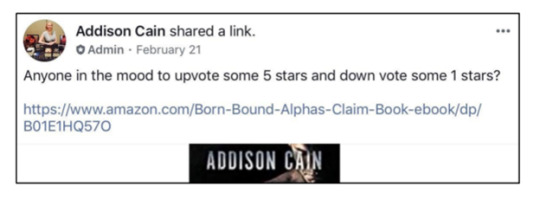
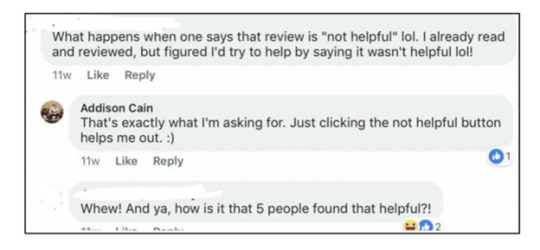
Idk, if the DMCA notice claims are true, they seem sketchy, but these communications don't strike me as that bad. The truth is, it's hard to know as an author when you're going "too far." You need to educate people as to what's helpful algorithmically, and upvoting five stars and downvoting one stars is helpful. That sounds like what she's doing, providing information so people know how they can help a writer they love. Presumably anyone doing this would seem to care enough about Addison Cain's books to spend time doing this. It doesn't seem from these excerpts like she's bribing people in any way. The second example seems especially bland to me, like, the reader seems to ask if it would be helpful to mark it "not helpful," so the reader brings it up, and then in response to Addison Cain they seem to say that they're shocked anyone would find the review helpful, which seems to me to imply that their "not helpful" designation was a true reflection of how they feel. Surely encouraging truthful and honest behavior on the part of your readers isn't a bad thing, and surely we would not ask authors to explain to readers how to be mean to them, instead of how to help them. So, I don't know, this part of the complaint strikes me as a little weak. I just don't think asking for people who liked your book to review it as scandalous as they seem to think. Like, their exhibit is titled "Review Manipulation," and it includes things like this:

(which, btw, afa I can tell, is her encouraging people to leave good review on *someone else's* book)
and

Idk, what do you think? Are you outraged by those?
Moving on:
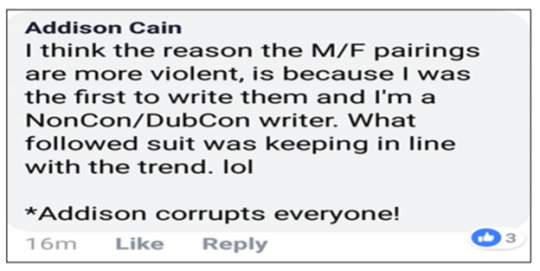
This does seem ridiculous to me. She does seem to think that she was the first to ever write a M/F Omegaverse (which the complaint alleges is provably untrue), but also seems to think that she therefore influenced the entire genre to be exactly like her. Idk. This just makes me think, like, ::raised eyebrow:: Who goes around saying "Oh, you know why that's like that? They're all copying ME!" Idk.
(Incidentally, it's interesting that she's claiming to own the straight version of the trope, that the straight version of the trope is the unusual version, because romance is in the mainstream culture dominated so much by straight love stories, and indeed every love-story example in the complaint is a het example. They use "The Runaway Bride" as an example of an enemies-to-lovers trope, which was SO WEIRD to me, I stared at it and was like, ....but all of Harry/Draco exists???? lol)
Asserting that on its own, though, would just make me roll my eyes a bit and move on. Coupled with the DMCA notice allegations, however, it does make it seem like she's trying to claim ownership over the entire M/F Omegaverse genre.
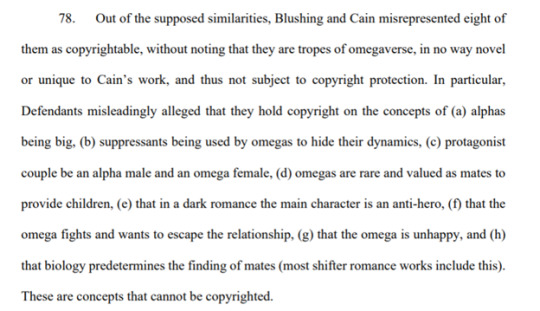
The similarities listed in the DMCA notice do seem like pretty basic aspects of the trope that I don't think anyone can own.
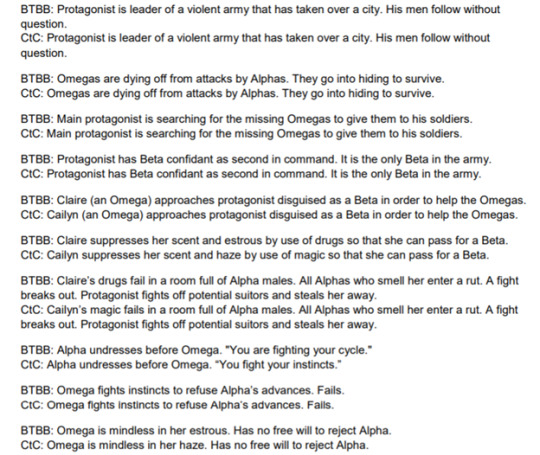
(There are more alleged. This is just the first few.)
But the DMCA notice does purport to contain reviews that say the two books are very similar.
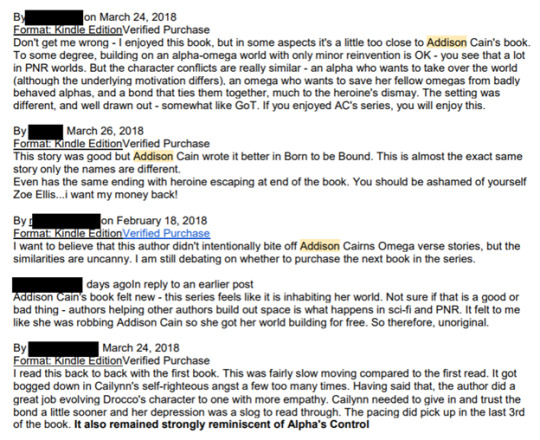
(Again, there are more, this is just a selection.) Part of me feels like maybe these people just haven't read much Omegaverse? Or haven't read fic, so they're not used to how tropes work? Idk. Without having read the books myself, it's hard for me to make this call. (And that's honestly how copyright infringement gets decided. You just have to read the books and decide if they're substantially similar in something copyrightable. Which apparently somebody did because the books were eventually reinstated as not infringing, it just didn't happen in a court of law. If this case goes on, eventually some judge is just going to have to sit down and read these.)
And of course the DMCA notice obviously chooses the most favorable to their cause, because there's also this:

If the only similarities are the rules...that just sounds like the Omegaverse trope.
The claims itself in this case are really interesting. It's not a copyright infringement case, because the plaintiff is specifically saying they are NOT infringing. Instead, the first claim is a copyright misuse claim (that you're using the monopoly granted to you by the government in an improper way, usually understood to be anticompetitive in a way that the government didn't contemplate as being part of the copyright grant). These are relatively rare but I think it's the right call, that using your copyright to send false DMCA notices would be copyright misuse.


The defendant has now answered the complaint denying the allegations. Indeed, the defendant asserts that the complaint is defamatory because it alleges Addison Cain has only filed one other DMCA notice in ten years of being a published author and thus she has not repeatedly manipulated the system to shame other authors. It also includes a counterclaim that alleges basically that this lawsuit has been brought for harassment purposes because it’s expensive to defend a lawsuit and they alleged that online sales metrics tell them that at most Zoey Ellis has lost about $2000 worth of sales.
So that’s where the case stands now.
Other miscellaneous observations:
--The complaint has spoilers for the end of Alpha's Claim which tell me I would never read that book.
--This is what the complaint lists as the common markers of the Omegaverse trope:
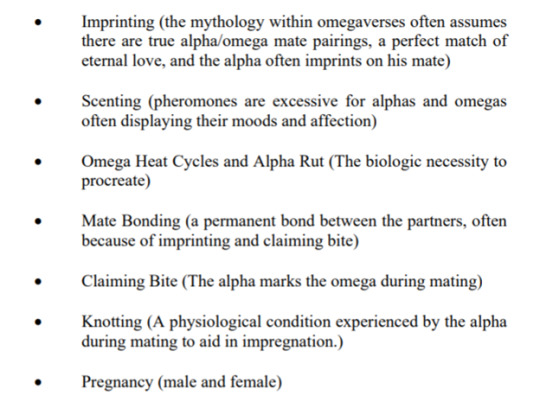
--
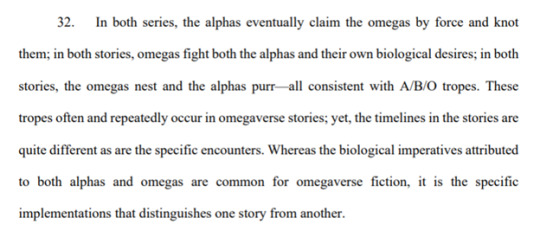
You know, people in Omegaverse fics often grapple really hard with consent issues, and I love when that happens, and I'm sad that's obscured in this paragraph. I mean, I know the point of the complaint isn't to talk about the ways in which the trope can be subverted, but anyway.
I'm not a huge Omegaverse person, but one thing I do often enjoy about it is how stark it makes the sexism of our patriarchal society, that the gender that breeds is so devalued and treated as dangerous and cordoned off and loses agency, etc. And then how straightforwardly it often has to deal with that. And I know M/M Omegaverse often skimps on female characters but I also like how much it drives that point home, that it's not a man/woman thing, it's literally just that as soon as someone has to bear the children, that comes attached with all sorts of burdens and expectations.
And I'm also not saying that every Omegaverse author sits down to grapple with those issues, or should be, or has to be. Just that Omegaverse can reveal so much about how we structure societies. And I'm sad that this complaint is just furthering this idea that fic doesn't really do anything profound or interesting or necessary and is just:

It's cool, not all fic/writing/creativity needs to serve GREAT INTERESTS, nor should it, but also I think a lot of fic/writing/creativity does, and that gets ignored in favor of dismissing it as frivolous. Idk. Obviously this complaint is not about solving that issue, but it made me think about it.
--

OR. Hear me out. They could get together and just cuddle for 100,000 words and banter and stuff. Just sayin'. Just throwing it out there.
--

I'm honestly really annoyed by this paragraph's wording. It sounds so condescending. "Employed a degree of creativity consisted with other 'fan fictions.'" I hate those quotation marks around "fan fictions," like they're not sure those are a real thing. So-called "fan fictions" (which, who calls them fan fictions anyway? who are they quoting there lol). But also, like, what's the "degree of creativity consistent" language. Like, the standard for copyrightability is that it possesses a modicum of creativity. That's it. It's a low bar. We know the phone book doesn't have a modicum of creativity but almost everything else has SOMETHING. So this strikes me as a little...sneering and dismissive, like, "Well, it's just as creative as other 'fan fictions.'" No. It's creative. Fic is creative. This is creative. It's an entire BOOK, that no one is alleging copies anything other than tropes (AS ALL PIECES OF FICTION DO, THIS IS NOT A FIC THING). It's got plot, characters, setting, dialogue -- none of which are alleged to be copied. So, like, just say it. It's creative. It possesses a modicum of creativity. Move on. I have no idea why that weird "fan fictions" reference is in there, Idk.
--They've got an exhibit that they claim is Addison Cain online statements about the plaintiff, but I can't make heads or tails of them. They're weirdness about how she's wrote the original M/F Omegaverse, but I don't see any references to the plaintiff author Zoey Ellis, other than very vague references like this:
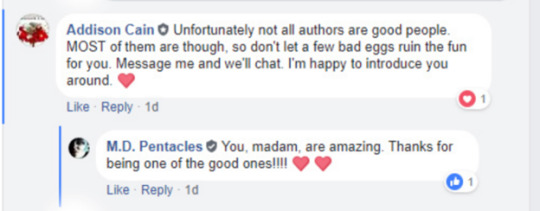
I'm a little bewildered by this exhibit. I think maybe they might be alleging that Addison Cain set up fake accounts to badmouth Zoey Ellis but if that's the case it's not clear to me, especially since they've blacked out the account name:
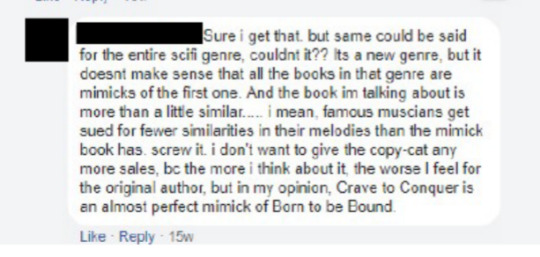
--This complaint has an exhibit that's basically an expert witness on Omegaverse. I love this so much. :-)
--Let's just enjoy this being in a legal filing:

--This isn't part of the main allegations. This is apparently, though, the kind of thing that Addison Cain has in the past considered plagiarism. Just a small selection, again, there are more. But:
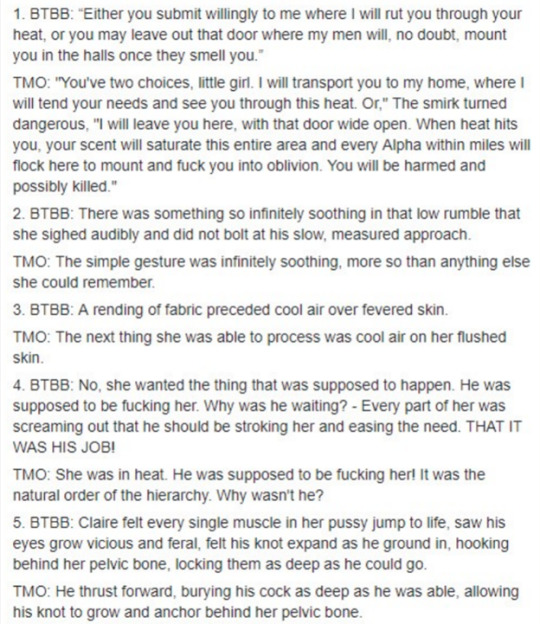
I have long said that writing a sex scene is like writing a cover letter: You’re trying to convey a very narrow series of events, over and over, and there’s only so many words you can use to do it. So comparing sex scenes like this just doesn’t make a lot of sense to me. Sex scenes will mostly inevitably sound similar in isolated sentences like this. It’s so funny, I was just saying to Aja about a gif, “He’s arching his neck to give him access like every heroine in every romance novel.” Because that’s a line we’ve all read in every romance novel.
--


Honestly, honestly, literally every single Omegaverse fic I’ve ever read has this exact moment. (And many of them do it better.)
--This complaint has taught me a lot about how much of a kink some people have for being covered in days’ worth of caked-on semen, rubbed into their bodies and massaged into their hair. Really, the complaint is kink-instructive, I recommend it.
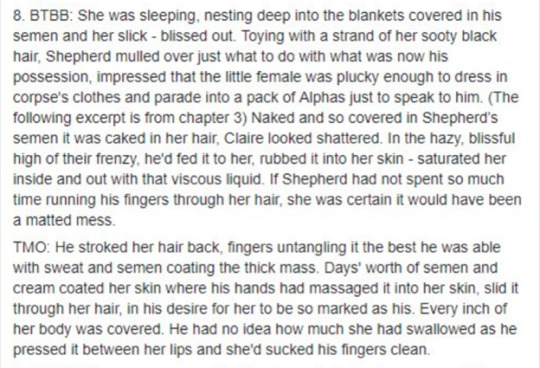

--Honestly to me the most damning thing about this is this exhibit where Addison took matters into her own hands to post the similarities between her book and another book, because I’m just not convinced by any of these, and if this is what she thinks copyright infringement is, then I doubt she understands what it is. Bull all these BTBB/TMO comparisons have been her making her case that these two books are similar, and I’m just dubious. And then stuff like this comes up:

Omegas being tired after a heat, yup.

They…both came up with a futuristic device that has a…screen?
She does end with this:
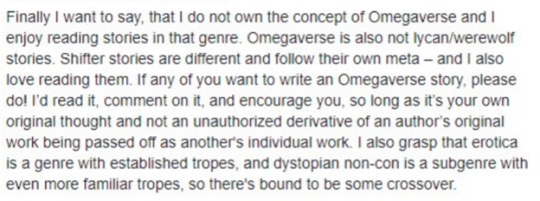
But I just don’t see what she’s claiming ownership of *other than* these really common Omegaverse tropes that I’ve read a million times. (Which isn’t to say that’s a bad thing. I’m a fic person at heart; I adore tropes.)
Anyway. That’s it. That’s the case so far. Let me know if you have questions, because lawyers can be bad at remembering what non-lawyers might be confused about.
In the meantime, I’m going to dig up some Omegaverse.
2K notes
·
View notes
Text
Hylics Part 2
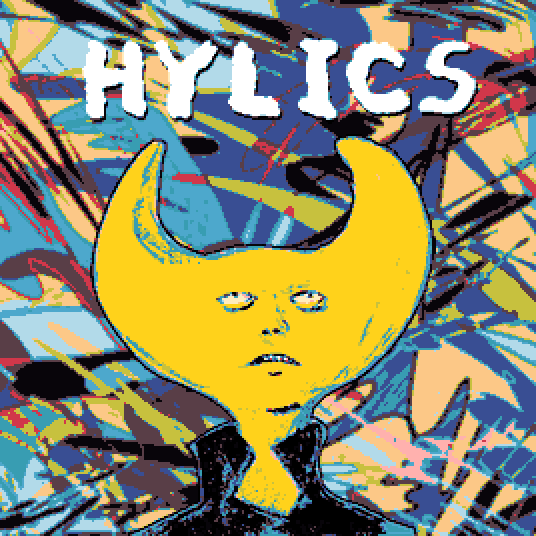
Okay, first off, hello to our massive influx of new followers! We look forward to writing for you all, and want to give a huge thanks to the folks over at @weirdmarioenemies for being so gosh-darned cool :) Now I have something to actually motivate me to write more reviews, so without further ado, here’s part 2 of our Hylics creature review!

Creature
For our first new creature, we have, well… Creature! Creature here is an optional boss that you can encounter in one of the overworlds. It seems to be made almost entirely of the most basal of all clay shapes: balls and snakes (there is no way you could possibly take that out of context so don’t even try it)! I do love the layout of this thing, even if it’s very simple. I feel like the appeal of a giant mass of writhing tentacles is relatively universal, but I also like that the only feature Lindroth elected to give it other than tentacles is a little cluster of pale eyeballs on top and to the front(?) of its body. You’d kind of expect it to have some kind of big, gaping maw full of teeth, and maybe it does! Like a lot of the other denizens of Hylics, there’s not much to them other than whatever we can discern from their sprites, and I think that’s fun! When killed, Creature drops a Chitin Jerkin, which is described as “Sensible everyday-wear for the modern machine” as well as a Parasite Crystal which just does some stat buffing stuff we don’t need to talk about, I just really like the names.
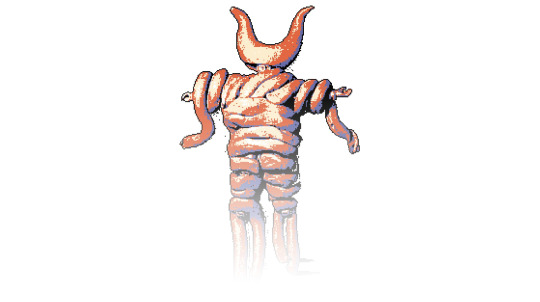
Ghost
Ooh, they’re peekin atcha! Peekin out through their wacky flesh spirals! The way the clay winds around the action figure part really gives off the impression that it’s some kind of creature wrapped around a human, like a flech mesh flesh mesh flesh mech! Especially since there are tendrils coming off the extremities that look like they would function as essentially extensions of the body within. Speaking of those extensions, I love that instead of just one projection coming off of each foot, there’s two! So instead of walking like a regular person, it walks using its four sub-legs. Also it’s got a cool funny hat that I kind of wish came down over the eyes so that it looked like the clay part was the head, but at the same time the eyes peering through the clay bits is really eerie.
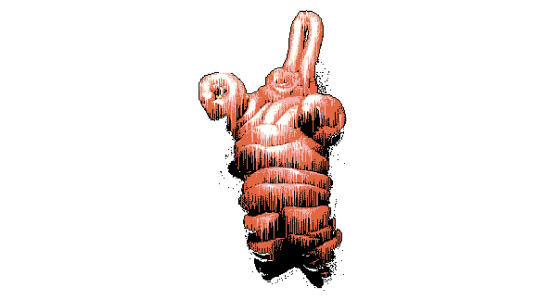
Dread Meat
Oh no, somebody left this boy out in the sun! They’ve gone all melty! Dread Meat is very similar to Ghost in its structure, however, its limbs do not have projections, and there is no trace of humanity to it beyond the hands and feet just barely emerging from what I can only imagine to be rolls of oozing meat. It feels like a zombie of some kind, although there is nothing else in the game that looks like it could be the un-undead version of this corpulent corpse. The thing I like most about its design is probably the fact that the head is a big loop with a grisled knot off to the right, presumably to hide the action figure head. It gives it some nice asymmetry.

Sub Shrub & Tomb Shrub
Oh my god. Adorable. These little green guys with huge lumpy wedges for heads and no discernible facial features should not be anywhere near as cute as they are. Also, I guess the name implies that these guys are plants? Anyway, Sub Shrubs can be encountered separate from Tomb Shrub, but they’re relatively weak on their own. But during the Tomb Shrub fight, it summons Sub Shrubs to help it out. Teamwork makes the dream work! I just love these little fellas! They look so squishy and silly! Also when he first encountered one, Vinny said the Sub Shrub looks like an “aborted pizza” and I can’t stop thinking about it.

Fathead
I was just thinking when I was writing Dread Meat’s review how fatty tissue isn’t something you see a lot in monster design, and here we’ve got this funky fella, whose head appears to be nothing but a massive glob of fatty tissue! I know there’s not much more to it than that, but it’s a nice concept for a creature and I like it a lot.

Monoops
Monoops’s gimmick seems to be its single eye… wait.
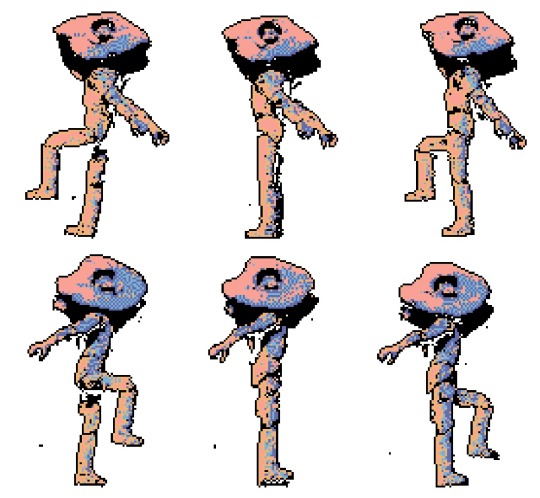
...Huh. I guess contrary to what the name would imply, Mono-ops has two eyes. That’s pretty neat actually! You don’t see many monsters with eyeballs as their design gimmick that have only two eyes. Usually, it’s either one or a whole bunch. It even has a move called Steady Stare that does damage as well as paralyzes its target, solidifying it as having an eyeball-centered design. I also really like the battle sprite’s color scheme.

Deadly Statue
Occupying a very similar role to the Ambulant Skulls, which you can read about in our last review of Hylics, Deadly Statues are only found in one area of the game. Similar to Ambulant Skulls, they kill you when you touch them, making them a purely overworld enemy. They are also much faster than Ambulant Skulls, matching the speed of the player exactly. Who'da thunk a big ‘ol statue’d be faster’n a skull made half’a legs?? Not me, that’s for darn tootin’! Anyway, I quite like its design. If I were an eccentric millionaire, this is exactly the kind of shit I would want sitting in the main foyer, flanked on either side by two huge, sweeping staircases of course.

Clawman
Clawman is the second-to-last boss in the game, they are equipped with two big yellow pincers and a ridiculously enormous head. I feel like the name and inclusion of pincers really makes you want to read it as a crab when really, the claws are the only vaguely crab-like feature they possess. You could argue that those spines on top are reminiscent to those of a king crab, but they’re flexible and curl inward towards each other like claws! That’s such a cute little touch!

Moon Soldier
Moon Soldiers barely qualify as enemies, since they literally can’t harm you, crumpling into a heap of bloody bones the moment you touch them. However, I think they’re really cool looking so we’re gonna take a look at ‘em anyway, god dammit. They guard the palace on the moon in which the final boss resides. It’s interesting how their heads are shaped much like that of our protagonist Wayne, (maybe they’re even the same species?) and the pale blueish color of the head against the cream of the clothes is really nice to look at. I kind of wonder if those are helmets they’re wearing, since the skull-like face markings almost look artificial, but there seems to be a very thin line between organic and synthetic in Hylics.

Gibby & Statues
Gibby is the main antagonist, and therefore the antithesis to our protagonist Wayne, who is a waning crescent instead of a waxing gibbous like Gibby, and instead of having a rad mohawk has no hair at all, which is basically the antithesis of having a rad mohawk. Gibby is, like, the king of the moon or something? I dunno, the plot in this game is kind of impossible to follow. If you’ve made it to the final boss, you’ve probably given up on trying to understand anything and are just here to see whatever batshit nonsense thing happens next. If you thought Clawman’s head was ridiculously huge, get a load of this guy! It looks like he can barely support its weight! How is it simultaneously swollen and gaunt? I dunno, but it’s kind of legitimately unsettling to be honest. It looks like his skin is pulled super taut over his face, almost like a desiccated corpse.
He also has two statues that aid him in battle. The Vital Statue to his right heals him, and the Eerie Statue to his left can afflict the protagonists with the nausea status effect. Can I just say how cool it is that there are four separate enemies in this game that have “statue” in their name, and they all look completely different? It’s really neat to see a single idea represented in so many different ways, ranging from somewhat recognizable to completely abstract. Most importantly, I think they’d all look lovely in the foyer of my imaginary mansion.
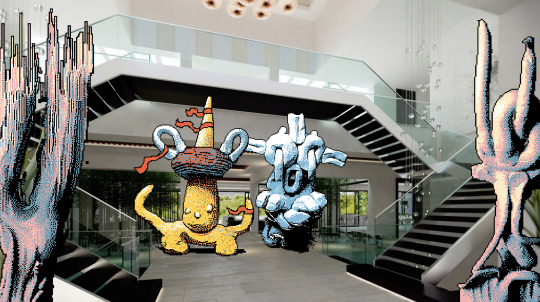
Conclusion

Hylics is a hell of an experience. It definitely has its flaws, such as clunky controls and practically nonexistent plot, but it’s at least worth watching someone play. The visuals are truly stunning, and you can really tell how much love went into making it. A huge portion of what you see in-game was painstakingly crafted from clay, rendered as a sprite, and worked into the game to become characters, enemies, and even the settings you walk around in. Please follow Mason Lindroth on Twitter, Tumblr or Instagram, where he is currently posting updates on the progress of Hylics 2, which looks absolutely gorgeous judging by what he’s shown us so far, and I’m so excited to play it when it’s done. Please also consider donating to his gofundme page to support him in his development of Hylics 2.

7 notes
·
View notes
Text
Hoshiai no Sora: Cast Comments
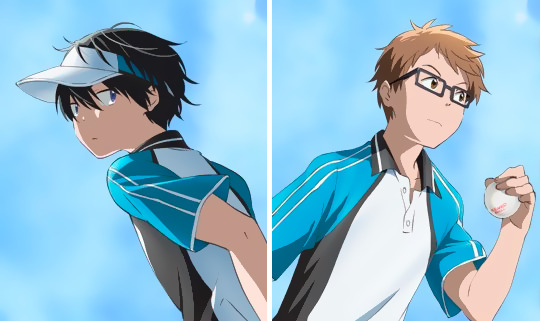
Q & A with the voice actors of the main cast. Translated from the official Twitter. Feel free to point out any corrections, and please check out some of the creators’ accounts:
Akane Kazuki (director)
Itsuka (character designer)
Takeshi (animator)
Kyuujou Kiyo (illustrator)
Takahashi Yuuichi (animator)
MLANG (animator)
Hanae Natsuki-san (voice of Katsuragi Maki)
Q1. Please tells us your impression about the character you play.
At first, I guessed he was a cool and behaved kid, but this changed into the impression that he was a child with no two-facedness to him and a feel-good personality, who firmly conveys his own opinions without being swayed by the people around him. Also, he laughs and makes merry in accordance to his age too, so it is fun to play him.
Q2. Please tell us a memory of club activities from your middle school days.
I was part of the soft tennis club, so I am extremely happy to get to perform in this production. Through this series, many things had me thinking, “This happens, this happens” and it makes me reminisce to my school days. I was the vice-president, but our tennis club was not that earnest about competing, so we did not go as far as Shijou Minami Junior High, but I believe the club activities had a similar air to them.
Q3. Leave a message for the people watching the series.
This is a work that touches the rare subject of soft tennis, while the number of schools that only have regular tennis gradually increases as one goes from middle to high school. It is a given for people who take part in soft tennis, but the delicate feelings of middle schoolers are also being depicted here through getting quite deep into their core, so I believe this is a series that makes the ones watching feel and think all sorts of things. Please watch over it until the very end.
Hatanaka Tasuku-san (voice of Shinjou Touma)
Q1. Please tells us your impression about the character you play.
Shinjou Touma is a child with an extremely strong sense of responsibility. The environment he grew up in has an influence on this, but he ends up exploding due to shouldering too many things and not knowing how to let it out when it became hard for him... The more I get to know him, the more I feel like giving him a hug. That’s the kind of person he is.
Q2. Please tell us a memory of club activities from your middle school days.
I was part of the basket club during my six years from middle to high school and on the bench. That’s why I would let my voice out higher than anyone, and since I could not manage to do anything whenever I entered the court, I would just run, anyhow. The nickname I earned from this was “Runner”. I was neither “center” nor “forward”, just “Runner”.
Q3. Leave a message for the people watching the series.
Honestly, I have absolutely no idea of how this work will be receptioned. But I thought, “I want to respond to the things that the director wants to write about and to his passion, from the bottom of my heart”. That’s why I had strong thoughts about getting close to the individuals that appear in this story, being hurt and moving forward together with them, and taking part in this series. I am truly glad to have become involved with it. Please do have expectations for it.
Matsuoka Yoshitsugu-san (voice of Ameno Itsuki)
Q1. Please tells us your impression about the character you play.
He is a boy with a deep darkness to him, except this darkness has a proper reason to be, so I look forward to when people get shocked upon finding that out. He is also a cute boy, so I hope people will enjoy the many emotions, expressions and lines from him.
Q2. Please tell us a memory of club activities from your middle school days.
I was in the wind instruments club, but I was always thinking about skipping. There were few guys in it, so whenever classes ended, a senior would often come to pick me up! Like, “Matsuoka! I’ll go with you!!” I really gave him a lot of trouble.
Q3. Leave a message for the people watching the series.
It is turning into a story that will not go through conventional methods. Many individuals of all kinds appear in it, but this is a series that depicts each human being very rawly, so I hope people will enjoy this rich story until the end. We also want to perform “Hoshiai no Sora” to our utmost, so we will be in your care from now on too!
Satou Gen-san (voice of Futsu Rintarou)
Q1. Please tells us your impression about the character you play.
Rintarou is a very serious and kindhearted person who can observe his surroundings better than anyone. On one side, he is extremely sensible, overthinks, does not manage to give his opinions and ends up hiding his true thoughts, so when I perform him, I make sure to do it while deciding in my mind, “Don’t leave Rintarou on his own no matter what” and, “Stay close to him until the end”.
Q2. Please tell us a memory of club activities from your middle school days.
I used to belong to the kendou club, but the club activities were aimed to win the nationals, so practice was extremely severe. During practice match expeditions, we would ride in the late-night bus and keep practicing from morning to evening non-stop just like that, and to make our bodies grow bigger, we would eat a mountain of curry, fist-sized minced meat fried cakes and gigantic hot dogs in one go until we got upset stomatches, so I have the strong impression that it was strict and terrible if nothing else.
Q3. Leave a message for the people watching the series.
I think its contents resonate with the hearts of both people who are currently students and people who are working as members of society. If they could love the characters of Hoshiai no Sora, who are somewhat heartrending but try to live day by day with utmost effort, I would be really happy.
Toyonaga Toshiyuki-san (voice of Soga Tsubasa)
Q1. Please tells us your impression about the character you play.
I have the impression that he is a child right in the middle of puberty, who ends up saying what he thinks aloud. It feels like he takes a while to find the will to do things, so I think he is simply carefree.
Q2. Please tell us a memory of club activities from your middle school days.
I was a ghost member of the basket club. I joined because a girl I liked back then was a member of the female basket club. My motive was impure, huh (laughs).
Q3. Leave a message for the people watching the series.
I think it will be pretty impactful for those who watch it thinking that it is an uplifting youth-and-sports thing. It depicts all sorts of problems that actually happen in reality. Please do watch these strong messages with your families; I would be happy if they become a trigger for people to reflect on things.
Satou Keisuke-san (voice of Takenouchi Shingo)
Q1. Please tells us your impression about the character you play.
I thought Shingo was an upfront kid in a very good sense. Also, I felt that, in contrast with his strong-look appearance, he is very considerate of his friends, has a side to him that’s got guts, and is adorable too. I am really looking forward to how he will progress from now on.
Q2. Please tell us a memory of club activities from your middle school days.
I was in the basket club, but all I did was slack off. There were only four members and the club activities only included running, and after that, we would do nothing but chat. Then we would run off so that the teacher of that period would not find us out (laughs). I would think, “One way or another, these are also memories of my youth”.
Q3. Leave a message for the people watching the series.
Developments that people cannot predict at all are waiting, and they make you extremely anxious. It is fully loaded with obsession for even minute details, so you will be unable to take your eyes off it from the beginning to the end! I hope to enjoy these moments together with everyone. “Hoshiai no Sora” is in your care!
Koyabashi Yuusuke-san (voice of Tsukinose Nao)
Q1. Please tells us your impression about the character you play.
Nao is a child whose appearance and mind are flighty, and also a mysterious kid who speaks of dellusions as if they were actually reality. But during club activities, he makes efforts in his own way so that he will not drag everyone down, so the gap between this and his fickle personality left an impression on me.
Q2. Please tell us a memory of club activities from your middle school days.
I was in the wind instruments club. I wanted to play the trumpet, but the pretty senior who was teaching us during the trial enrollment played the horn, so I was swayed by her sweet talk, and before I realized it, I was playing the horn myself (laughs). I should beware of sweet temptations, is what I thought during my middle school years.
Q3. Leave a message for the people watching the series.
People might get tripped up if they are watching it thinking that it is an anime where children are enjoyably playing soft tennis to their utmost. It is precisely because those kids are at that age that I would like people to observe thoroughly the depiction of the mindsets they embrace.
Amasaki Kouhei-san (voice of Ishigami Taiyou)
Q1. Please tells us your impression about the character you play.
I think Taiyou-kun is a gentle child. He cannot decide things on his own, always taking action by matching up with other’s opinions. I felt that the way his Kansai dialect sometimes has a common language ring to it was realistic.
Q2. Please tell us a memory of club activities from your middle school days.
I was in the swim club. During summer, we would swim over 10km from morning to evening. We would run the competitive club relays in the PE festival wearing one layer of swimsuit. I think it was an experience I can no longer manage.
Q3. Leave a message for the people watching the series.
“Hoshiai no Sora” is a work made extremely carefully, and even during the post-recording, the love I can feel from the creators is huge, so I think it is a very good series. There is not much I can say, so I hope you all can see for your own eyes when you watch it on-air! We will be in your care!
Mineda Mayu-san (voice of Mitsue Kanako)
Q1. Please tells us your impression about the character you play.
When I first saw her, I thought, “I guess she’s a shy and quiet girl?”, but that was splendidly betrayed. Kanako is the type to straightforwardly say what she thinks to the other party, and I think this aspect of hers, in a good sense, reeks of humanity quite a bit.
Q2. Please tell us a memory of club activities from your middle school days.
I was the president of the art club, but I would walk around campus after school and observe the activities of other clubs. That includes the soft tennis club and the like. To all the art club members of back then, I’m sorry for being such an undisciplined club president...
Q3. Leave a message for the people watching the series.
This story intersects with the many emotions of middle schoolers living in the current era, who might actually exist somewhere within Japan. Also, the sounds of batted balls and squealing of sneakers are very real and have intensity, so I would like people to pay attention to them as well.
Yamaya Yoshitaka-san (voice of Asuka Yuuta)
Q1. Please tells us your impression about the character you play.
He is androgynous and has a soft demeanor, and I think he is truly a boy of kindhearted disposition. He somewhat lacks confidence, so he steps back and has a bird’s-eye view of things, but there is a reason for it. I would like people to pay attention to him along with the other characters’ worries.
Q2. Please tell us a memory of club activities from your middle school days.
I was in the soccer club. I had many experiences, like how plain fun it was kicking the ball, having awkward relationships, and learning the joy of getting sweaty doing practice and winning.
Q3. Leave a message for the people watching the series.
This is not just a multi-protagonist story about the youth of bright and uplifting boys. Troubles and issues that surely exist somewhere out there, though people usually do not try to look at them, are depicted realistically in it, and there were times it made my chest hurt. I want everyone to watch how each of them will face the things they are shouldering until the very end.
#hoshiai no sora#stars align#sportsanimedaily#fysportsanime#hns#hoshisora#katsuragi maki#shinjou touma#asuka yuuta#asuka yuu#ameno itsuki#futsu rintarou#soga tsubasa#tsukinose nao#takenouchi shingo#ishigami taiyou#mitsue kanako#hanae natsuki#hatanaka tasuku#matsuoka yoshitsugu#satou gen#toyonaga toshiyuki#satou keisuke#kobayashi yuusuke#amasaki kouhei#mineda mayu#yamaya yoshitaka
82 notes
·
View notes
Text
Weekend Top Ten #432
Top Ten Games to Remaster
As we continue June’s videogame-themed series of Tops Ten – during what would normally have been E3, but is still something of a prolonged Videogame Announcement Season – I turn my attention once again to great games past. This has been exacerbated by the release of Command & Conquer Remastered Collection, a hi-def spit-and-polish re-do of two of the greatest PC games of the nineties. I have very fond teenage memories of both C&C and its pseudo-sequel, but Red Alert in particular strikes an important chord as one of “the” games that deepened and broadened by love of gaming as an art form. In the way that really only happens when you’re a kid, I absorbed Red Alert, not just completing the campaign and playing hours and hours of skirmish, but also talking about it extensively with friends, designing my own levels, and even going so far as to modify the source files to create my own super-units (nuclear tanks ahoy!). As such, it utterly delights me to declare that C&C Remastered is a phenomenal undertaking, the graphics painstakingly remade to fit modern displays, the interface masterfully tweaked to appease modern sensibilities. But at the same time it offers so many pleasing, knowing, considerate hat-tips to fans, such as a re-imagining of the classic DOS installation prompts. All in all, it’s a must-buy, bringing a 25-year-old series of games more-or-less bang up to date and preserving their legacy for a new generation.
Anyway, all this got me thinking of other classic games, and how it’s so difficult to play them nowadays. Maybe they’re mired in rights issues. Maybe it’s a technological minefield to get them to run on modern systems. Maybe elements of modern gaming – be it graphics or design – have simply passed them by, making them a far more difficult and frustrating experience than they would have seemed Back in the Day. Whatever the reason, these are games that – like classic films from the 40s and 50s – should be celebrated and enjoyed by the young’uns, not left to gather digital dust on forgotten floppies the world over.
So, with no further ado, here are ten games that I would love to see given a bit of digital TLC, renewed and revigorated for the ultra-wide monitors and liquid-cooled systems of tomorrow. In most cases these are just one game that I’d like to see spruced up and re-released, but there are a few “collections” here too, whether it’s a C&C-style pairing of a great double act, or a celebration of a series, a la Halo: The Master Chief Collection.
Oh, and I’m on about remasters here: not a full-on remake or reboot. Stuff like Perfect Dark on the Xbox 360, not Doom 2016. Old games made good on modern hardware, not a reimagining of the property.
Regardless: have at it, games industry.

Lemmings (1991) and Lemmings 2: The Tribes (1993): I definitely think they should be a double-pack, because whilst the first is a well-regarded classic, the second refines the formula, makes it more user-friendly, offers skirmish-style training modes, and amps up the comedy. But they’re both ancient by now, and despite mobile do-overs in recent years, the originals are very difficult to play. Upping the resolution whilst still keeping the character of the scantily-pixelated sprites would be difficult, but it’d be worth it to once again sample one of the gods of gaming.
Sam & Max Hit the Road (1993): other LucasArts classic adventures have had a spruce – most notably the first two seminal Monkey Island games – but it’d be good to see this cult comedy classic come back to life. I don’t know if the backgrounds ever existed in higher resolution, but I’d love to see the sprites re-drawn to more closely resemble a cartoon version of Steve Purcell’s artwork.
The Jedi Knight Series (1995-2003): I’m bundling all four Jedi Knight games in together – that’s the original Dark Forces, plus Jedi Knight, Jedi Outcast, and Jedi Academy – but let’s be honest, it’s the first two we’re really after. DF gave us a compelling mission-based “Doom Clone” (back when Doom was a genre), and one which would be amazing to see tarted up to 4K with texture filtering a-go-go; but it was its 1997 sequel, Jedi Knight: Dark Forces II, that struck serious beskar. Huge, expansive levels, in “true 3D” (as we used to call it), full-motion video cutscenes, finally getting a lightsaber and Force powers, but most of all the Light/Dark Side dynamic offering (very basic) morality and a branching storyline. Again, giving it a glossy hi-def sheen would do wonders to preserve the legacy of one of the greatest Star Wars games of all time.
The Quake Collection (1996-2005): really it should be called The Quake Qollection, no? Encompassing all four mainline Quakes. Although, again, let’s be honest: there’s something deeply iconic about the first three, so no one would complain if we just forgot about part 4, yeah? Anyway: Quake was a stunner, a gorgeous 3D technical juggernaut, offering sumptuous lighting effects and gorgeous architecture. Part II came a year later and offered us coloured lighting and a coherent sci-fi story, whereas Quake III Arena in 1999 gave us a sublimely crafted multiplayer shooter and a character that was an eyeball doing a handstand. Despite being graphical powerhouses in their day, getting them to run can be a drag, so it’d be lovely to see them dragged into the 21st Century, especially if they could offer us ray-tracing on next-gen consoles, a la Quake II RTX.
Tomb Raider (1996): we’ve seen the series rebooted in (generally) excellent fashion, but at the same time it feels it lost a little of the majesty, mythos, and merriment of OG Lara. One of the first truly successful 3D games, it was like nothing before it. A subtle update to increase its resolution, filter the rough edges, maybe offer the option to move beyond the rigid grid-based movement structure, and possibly up the poly count so blocky Lara more closely resembles her rendered box-art cousin, would be terrific. Imagine the dinosaur in 4K…!
Descent (1994): one of those games that’s slipped from public consciousness, this was a full-3D shooter a couple of years before Quake shambled onto our screens. Piloting a craft in zero gravity, it offered full freedom of movement as well as a tense shooter dynamic coupled with some mild, X-Wing-style space sim elements. It was funky, fast, gorgeous, and messed with your head. I’d love a remake that kept the levels as-is, simplified the often-complex controls for modern sensibilities, and just in general made it look prettier. I worry that a contemporary “re-imagining” might lose too many of its crazy rough edges, though.
Syndicate (1993): there have been a number of efforts to re-do Syndicate over the years, but apart from its excellent sequel Syndicate Wars in 1996, none have matched the dark joys of the original. rather than try to go all modern and 3D, I’d rather see the artwork redone, redrawn at a higher resolution, perhaps offering subtle 3D touches such as dynamic light, shadow, and ray-tracing. The fiddlier aspects (getting into cars?!) could be tidied up, but the look and feel should remain the same. I honestly think this could be a big deal.
Total Annihilation (1997): if C&C can get remastered, why not the game that was arguably the first real challenger to its sci-fi RTS dominance? TA had 3D graphics, a new and refined model of base construction, and tactical touches such as line-of-sight and elevated terrain. But the comparatively low resolution of late-nineties machines meant that the robotic units could often appear slightly indistinct, turning into a grey melange; boosting the res and the poly count would do wonders, but – like C&C – the gameplay itself should be kept as authentic as possible.
Warcraft I & II (1994-95): I know, I know; they just did a remaster of Warcraft III that wasn’t well received and got everybody’s backs up. But I barely played Warcraft III (I barely played Warcraft I for that matter). Warcraft II: Tides of Darkness was the fantasy yin to C&C’s sci-fi yang, and it was great; clear, bright, fast, fun. The cartoony graphics were gorgeous and the units had bags of character (reinforced by the humorous soundbites when you kept clicking on them). I’d want to see the sprites re-drawn in hi-res, with the units given some gorgeous new animations to match their character. Other than that? Keep it broadly the same. It worked 25 years ago, it’ll work now.
Fantasy World Dizzy (1989): I nearly didn’t have a game this old on the list. For one thing, I thought pre-16-bit games would require far more retooling for modern audiences, becoming essentially the sort of reboot I said I wanted to avoid; I can’t imagine a new Skool Daze being too similar to its original. Also which Dizzy do you choose? The one I played the most was probably Spellbound (1991). But I think Fantasy World may be the most iconic. Its Amiga port was almost a remaster anyway, giving it gorgeous colour graphics. A modern version would up the resolution with all-new art assets, obviously, and perhaps could offer a more user-friendly jumping dynamic (and maybe – maybe – I’ll allow scrolling). This could be a lovely way to re-introduce audiences to the character of Dizzy, who should really be held up more as a British gaming mascot, without having to go all-in on a brand new title. Egg-cellent (sorry).
So there we are. There are a couple missing here, obviously; Simon the Sorcerer was nearly there until I realised they did do a gentle remaster in 2018. The Settlers would have made the list, except they are remaking that, although in my opinion it looks like a full-on reboot rather than the upgraded version of the original that I crave. Fade to Black just dropped off the bottom on the grounds that I barely played it in its original form, but a third-person 3D Flashback is still on my Most Wanted list (Flashback itself, sadly, has already had a disappointing remake). And the best Star Wars game of all time, Knights of the Old Republic, I decided not to include as – again – I think we’re going to see that reimagined and folded into the new official Disney canon in some form. Maybe that should preclude me imagining the original game in 4K with updated character models, dynamic shadows, and ray-tracing, but – hey – that’s just me. At least that is one game that I’ll still be able to play fairly easily on an Xbox Series X, even without whistles and bells. Here’s to dead old games!
#top ten#games#gaming#remasters#old games#retro games#command & conquer#lemmings#star wars#dizzy#warcraft#quake
2 notes
·
View notes